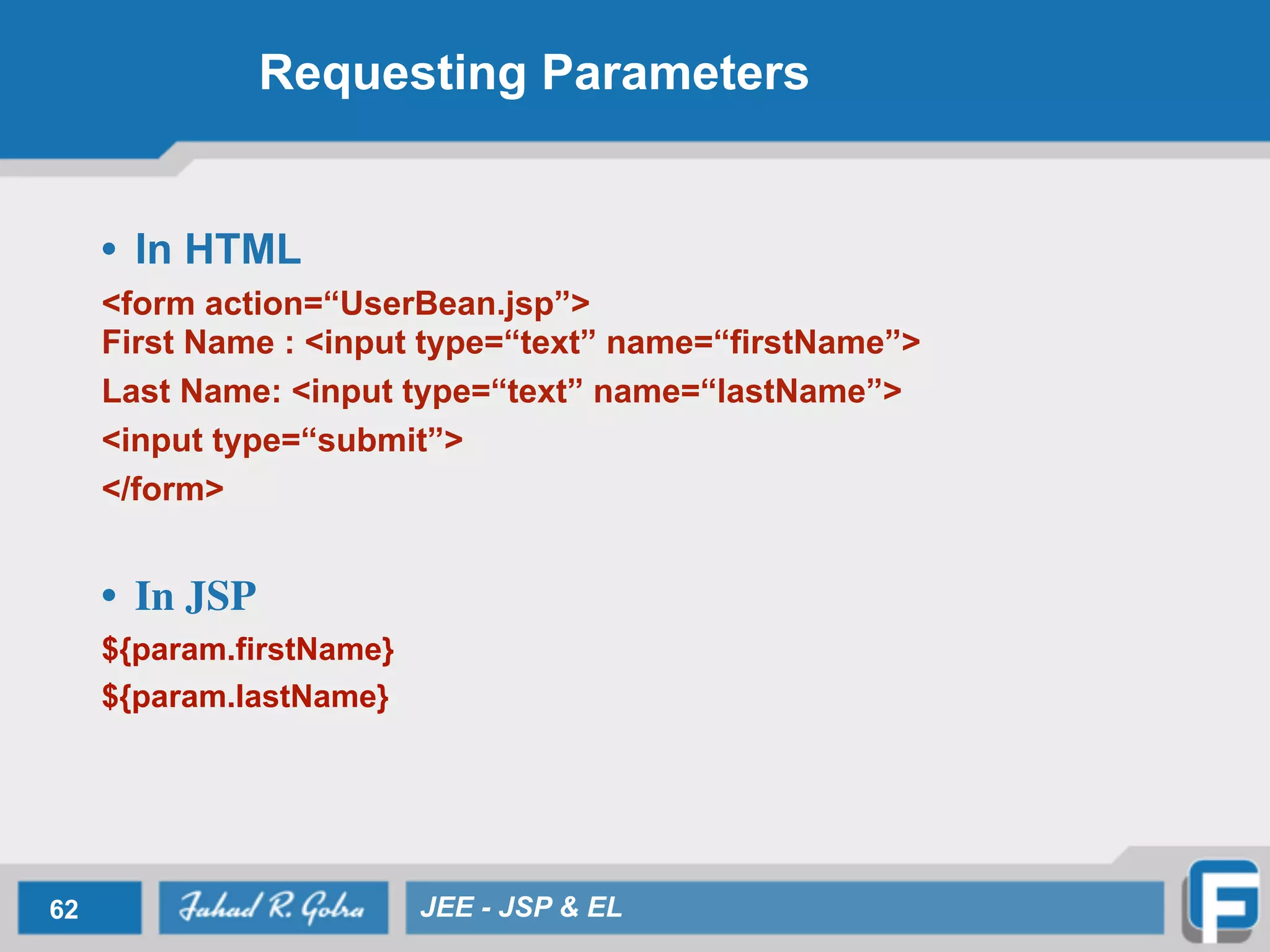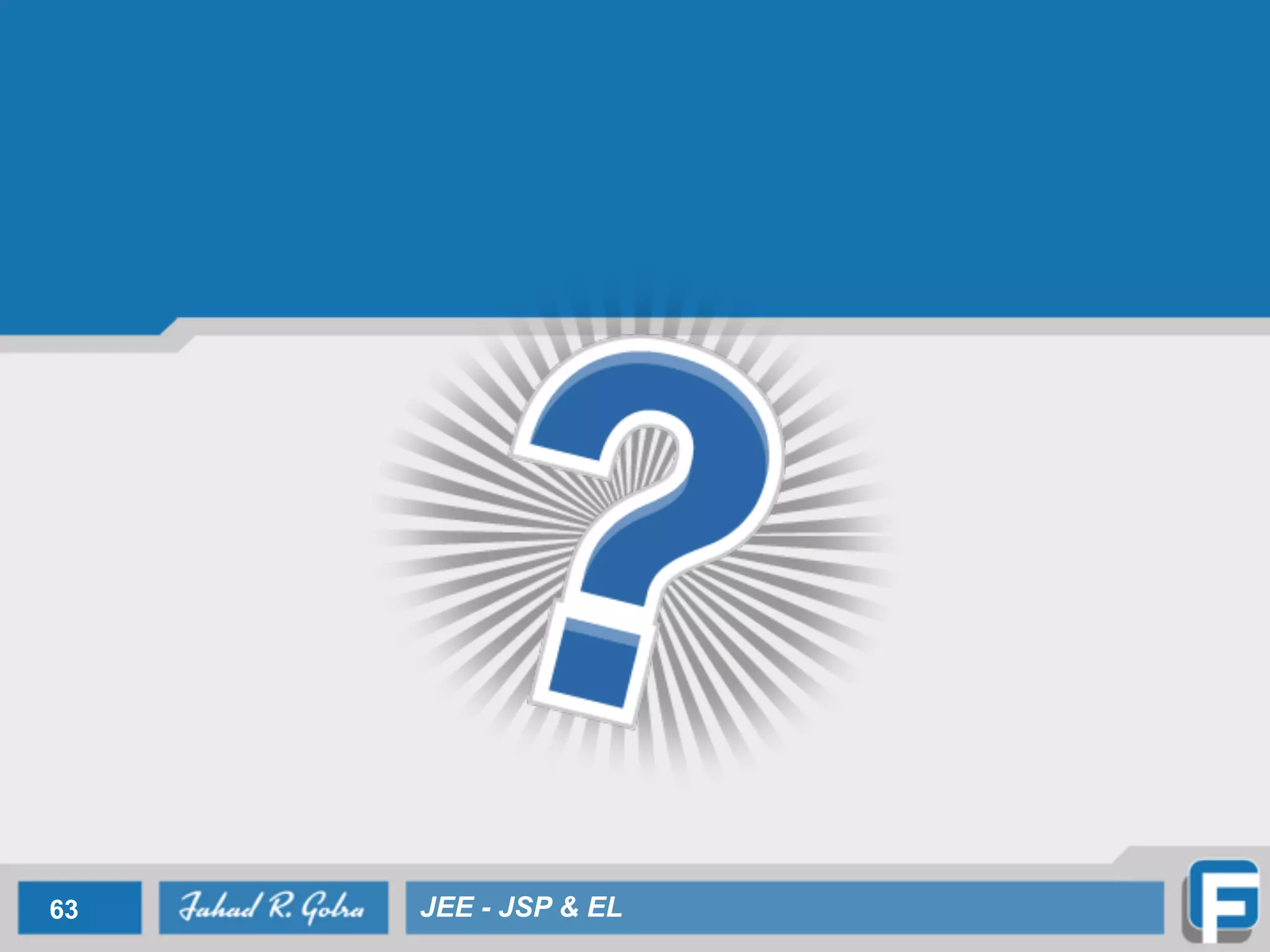The document discusses JavaServer Pages (JSP) and the Expression Language (EL) in JEE. It covers key JSP concepts like scripting elements, directive elements, standard action elements, and implicit objects. It also explains the translation of JSP files to servlets, and provides examples of using scripting elements, directives like <jsp:include>, and standard actions.

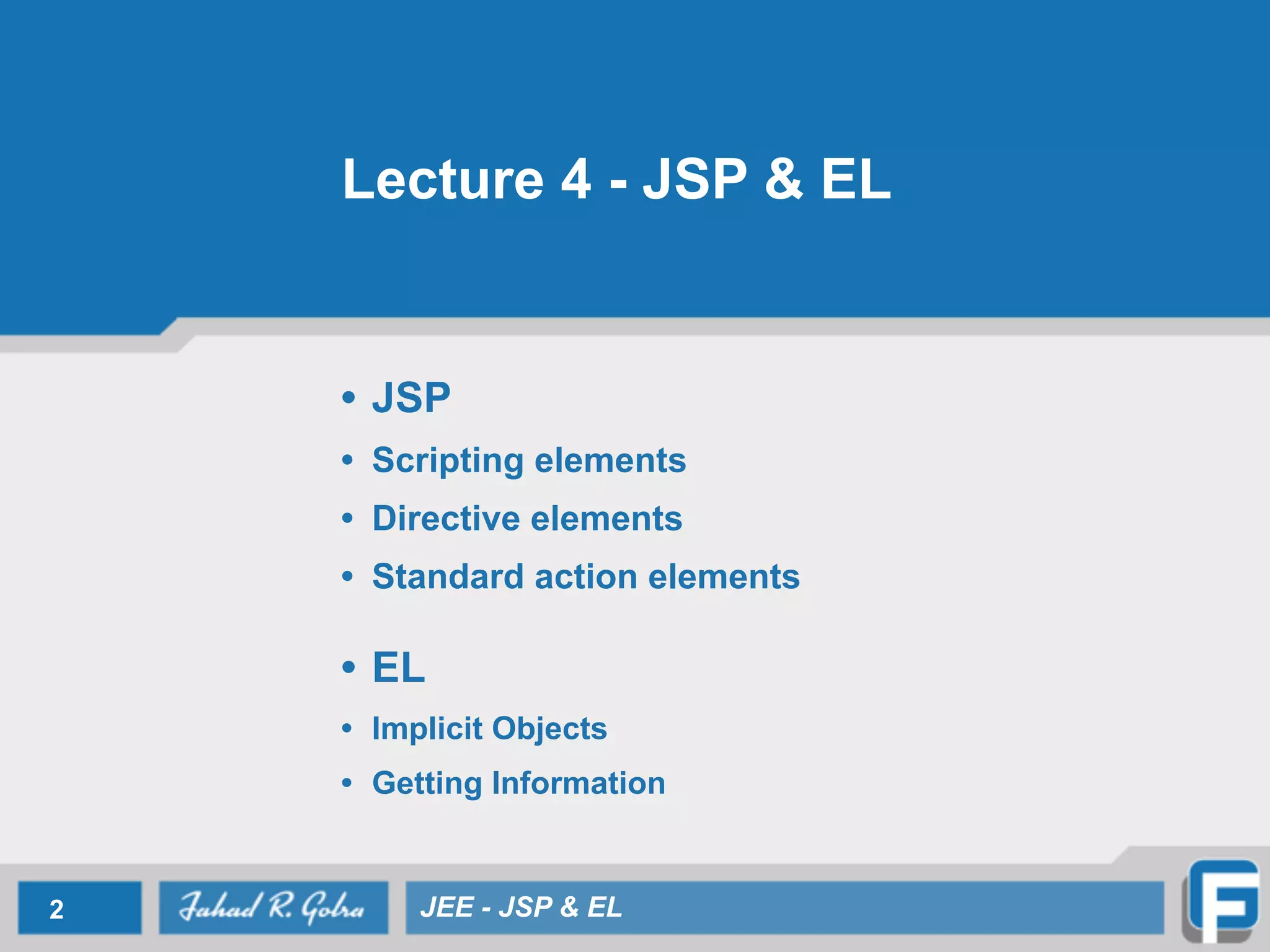
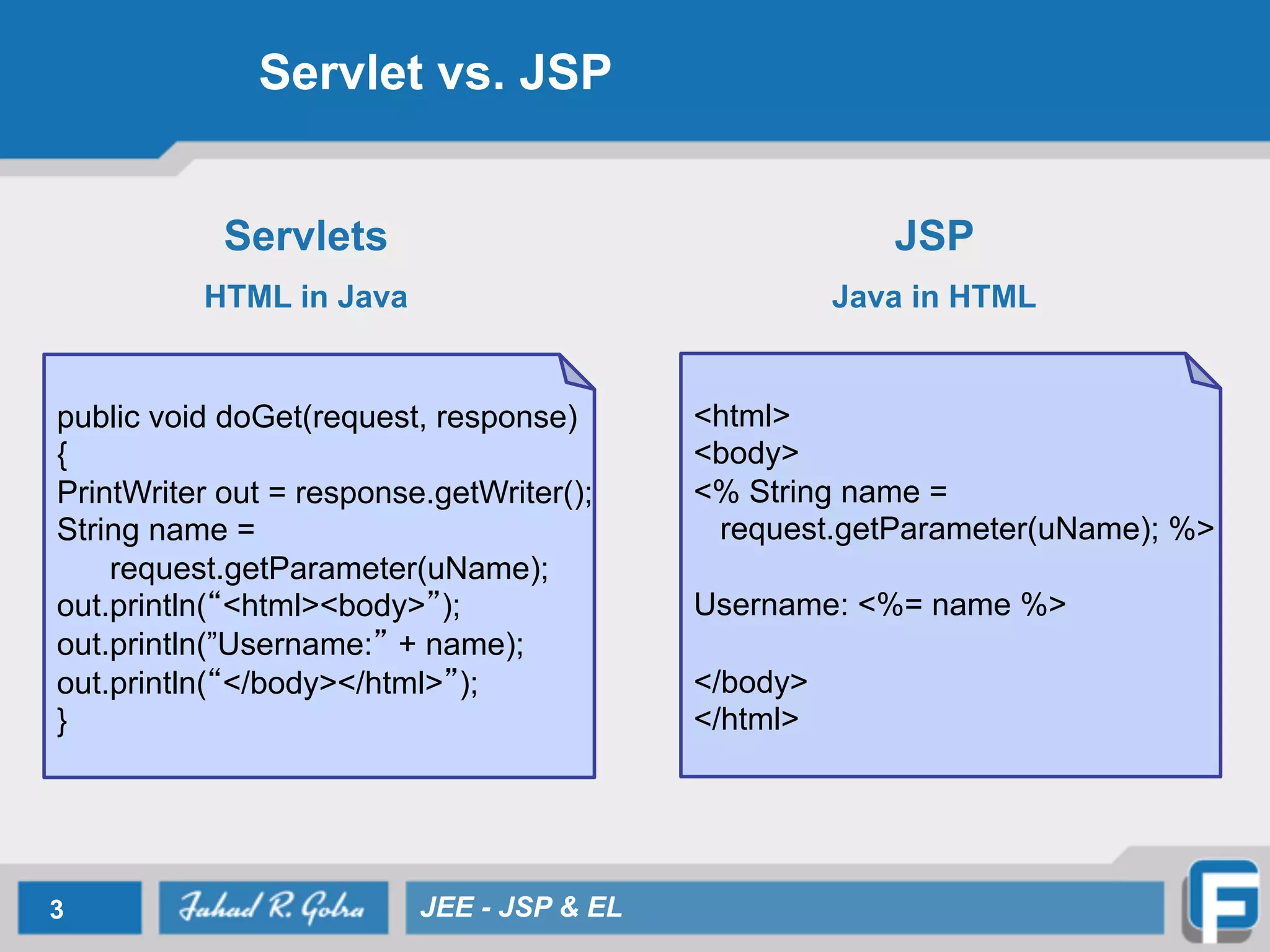
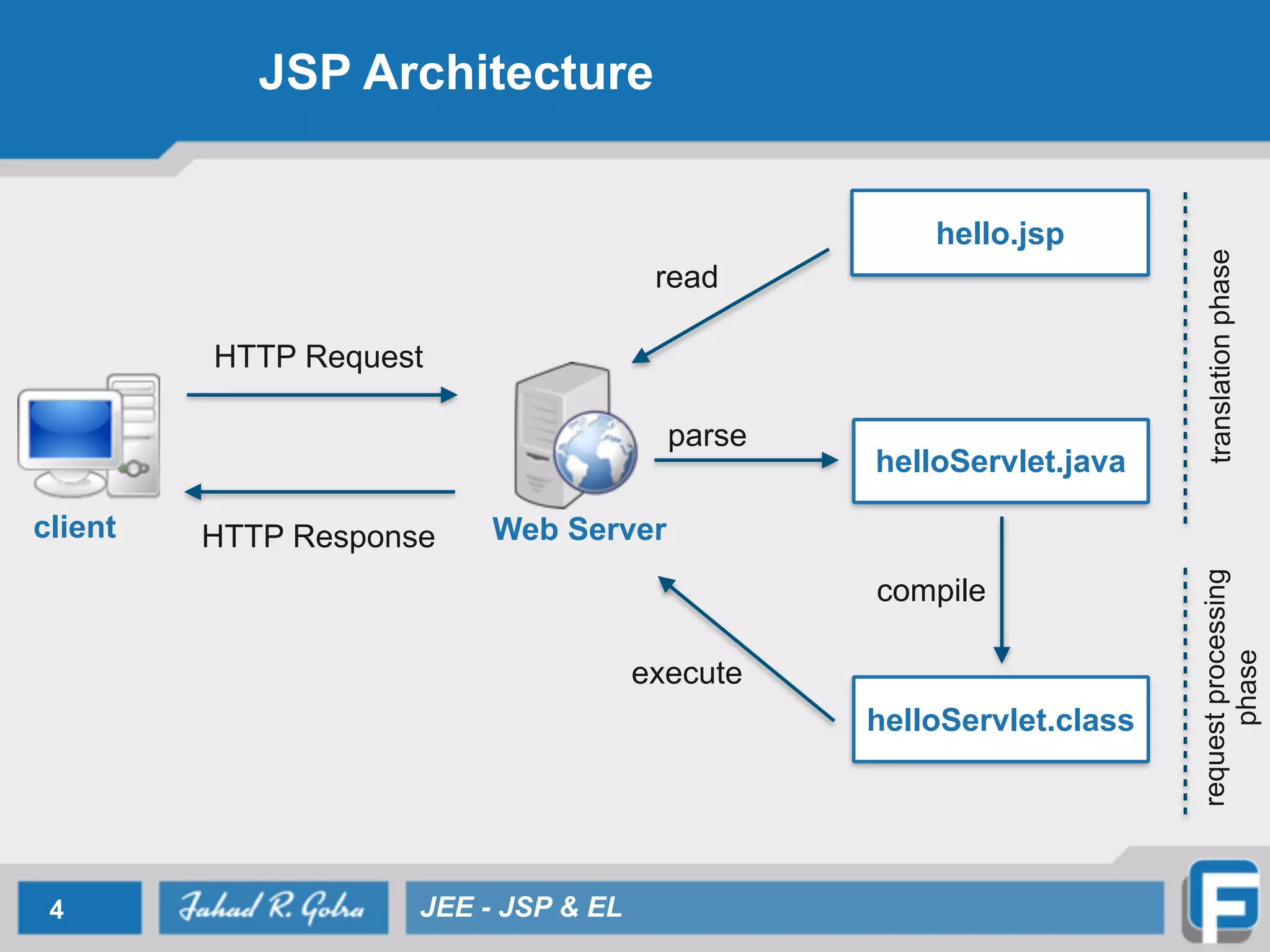
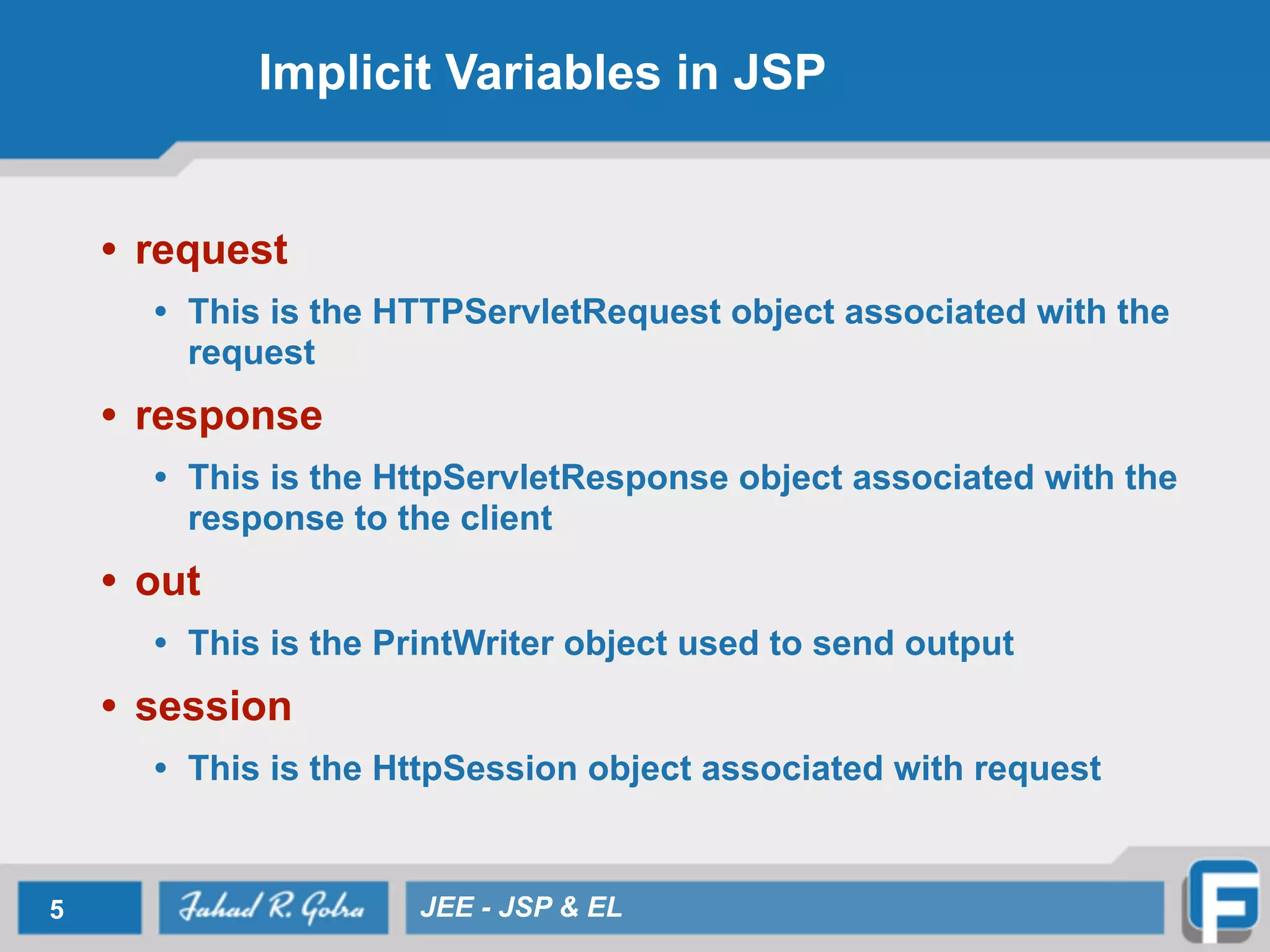
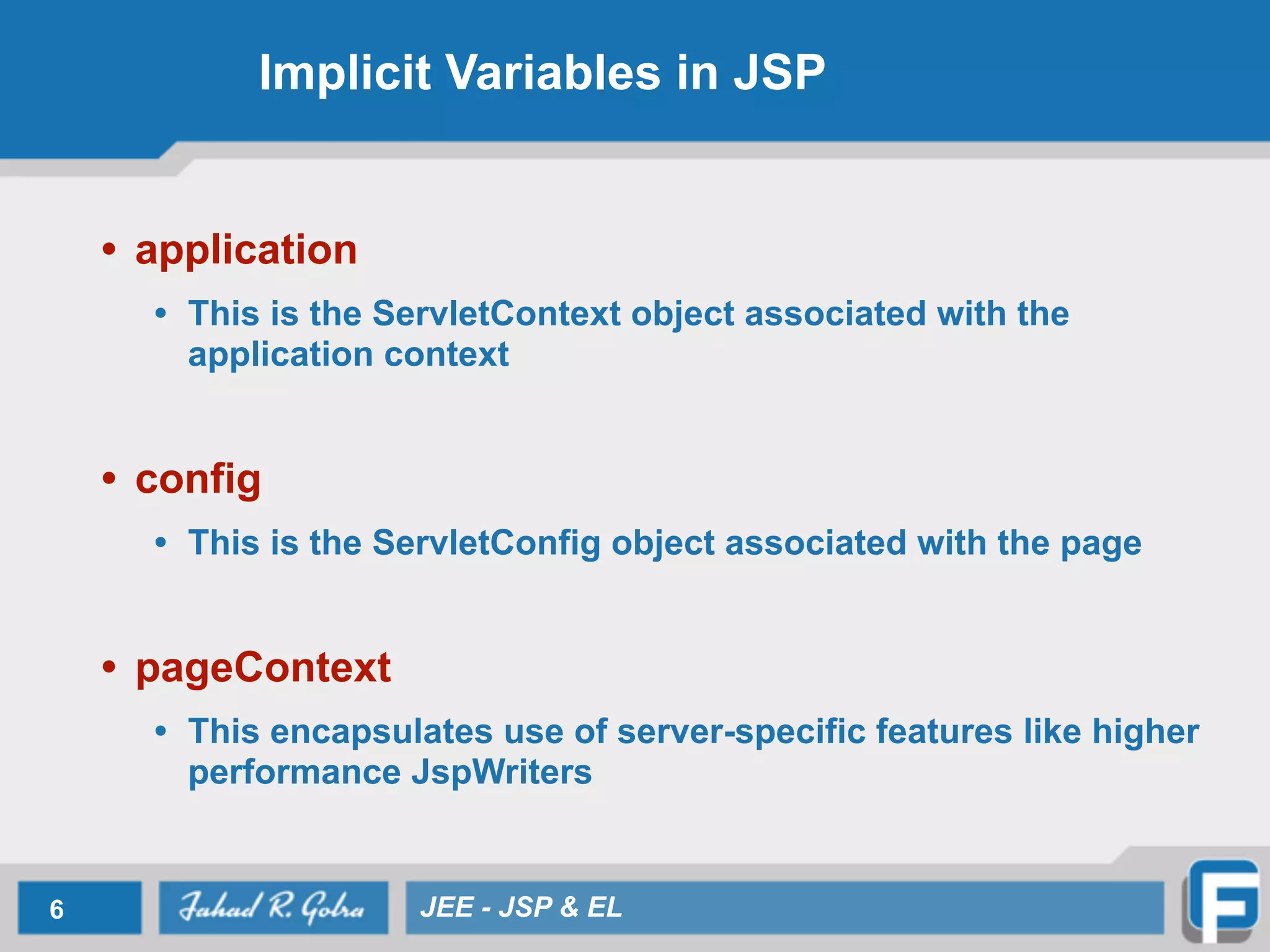
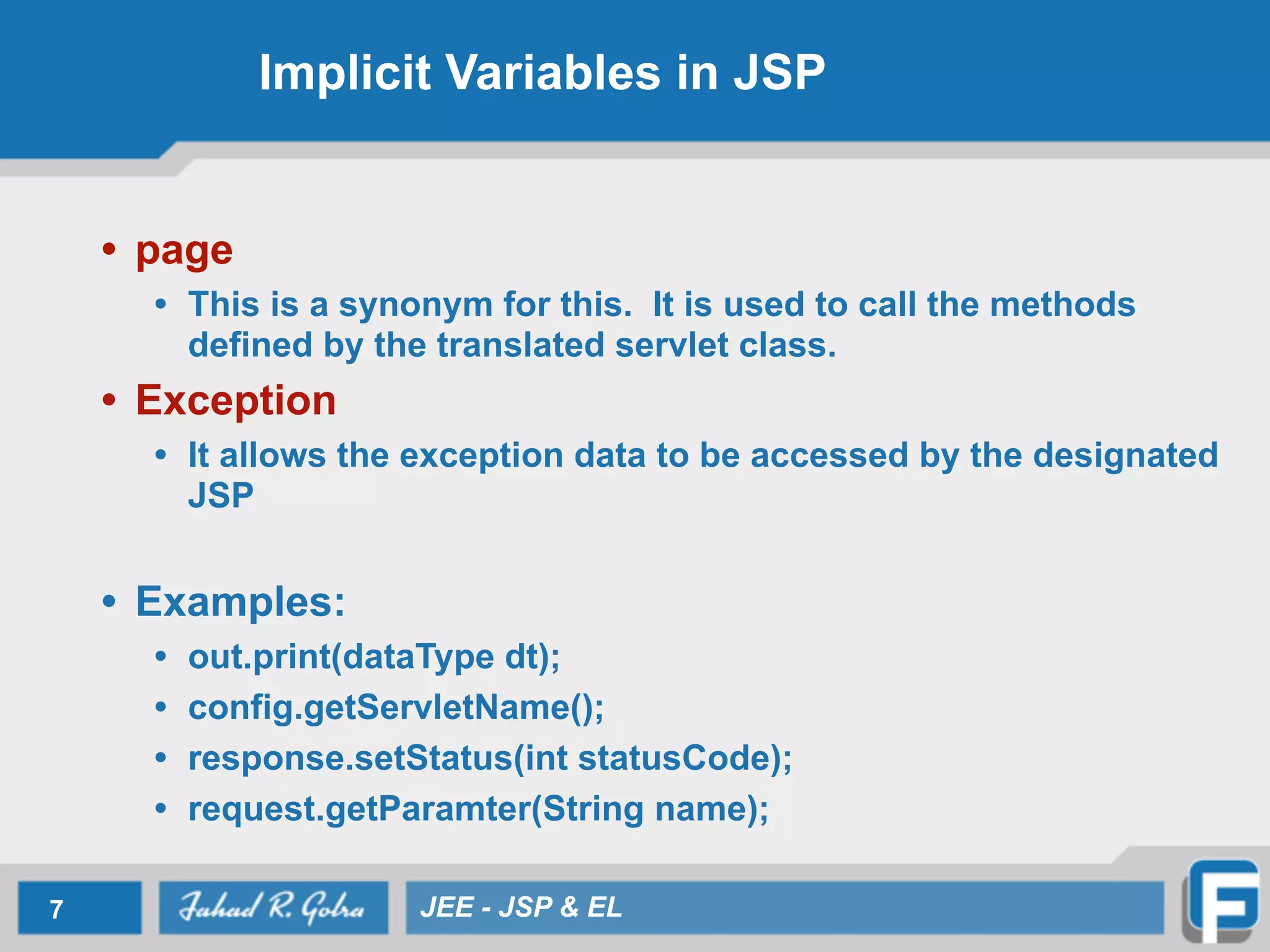
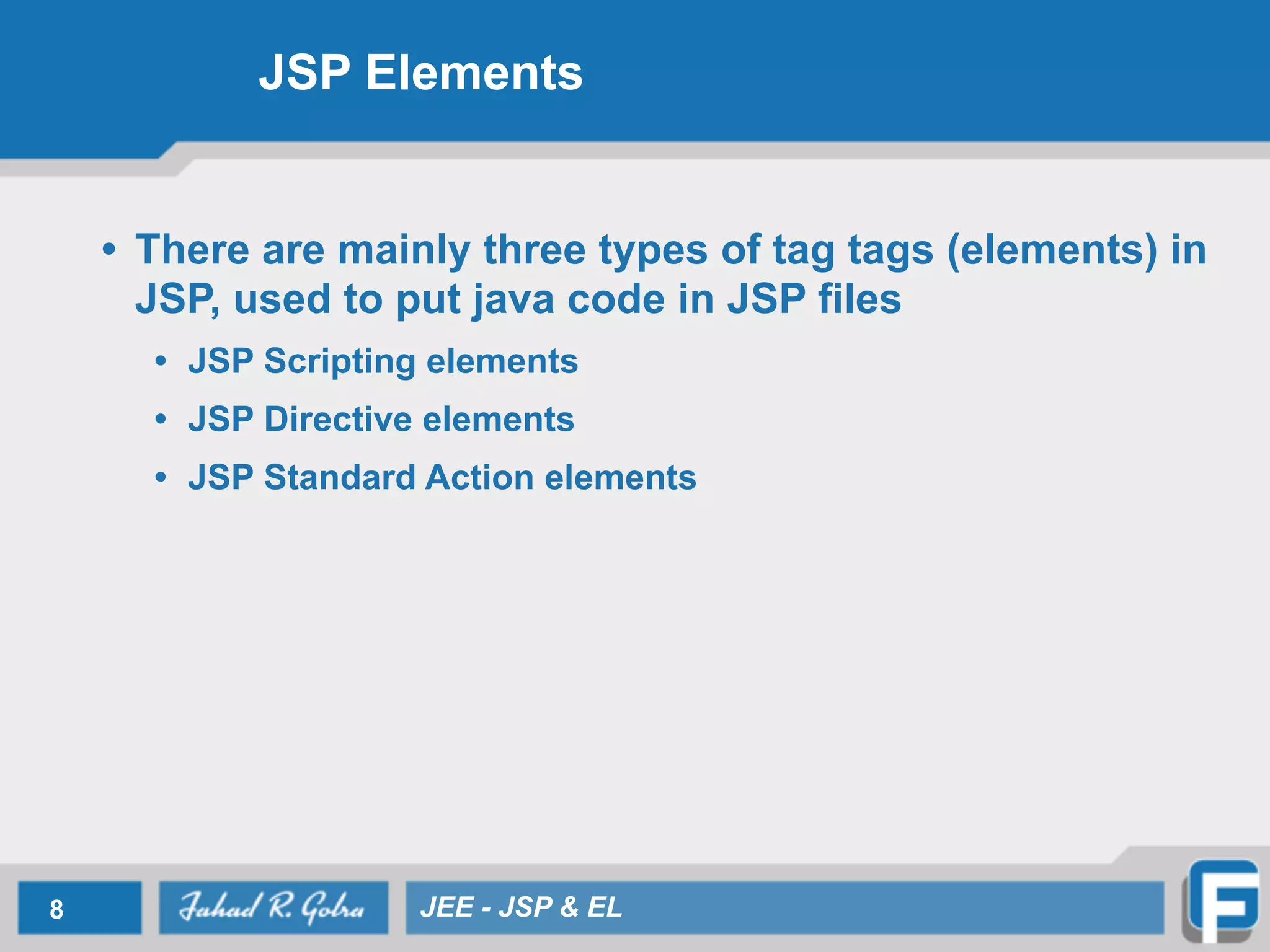
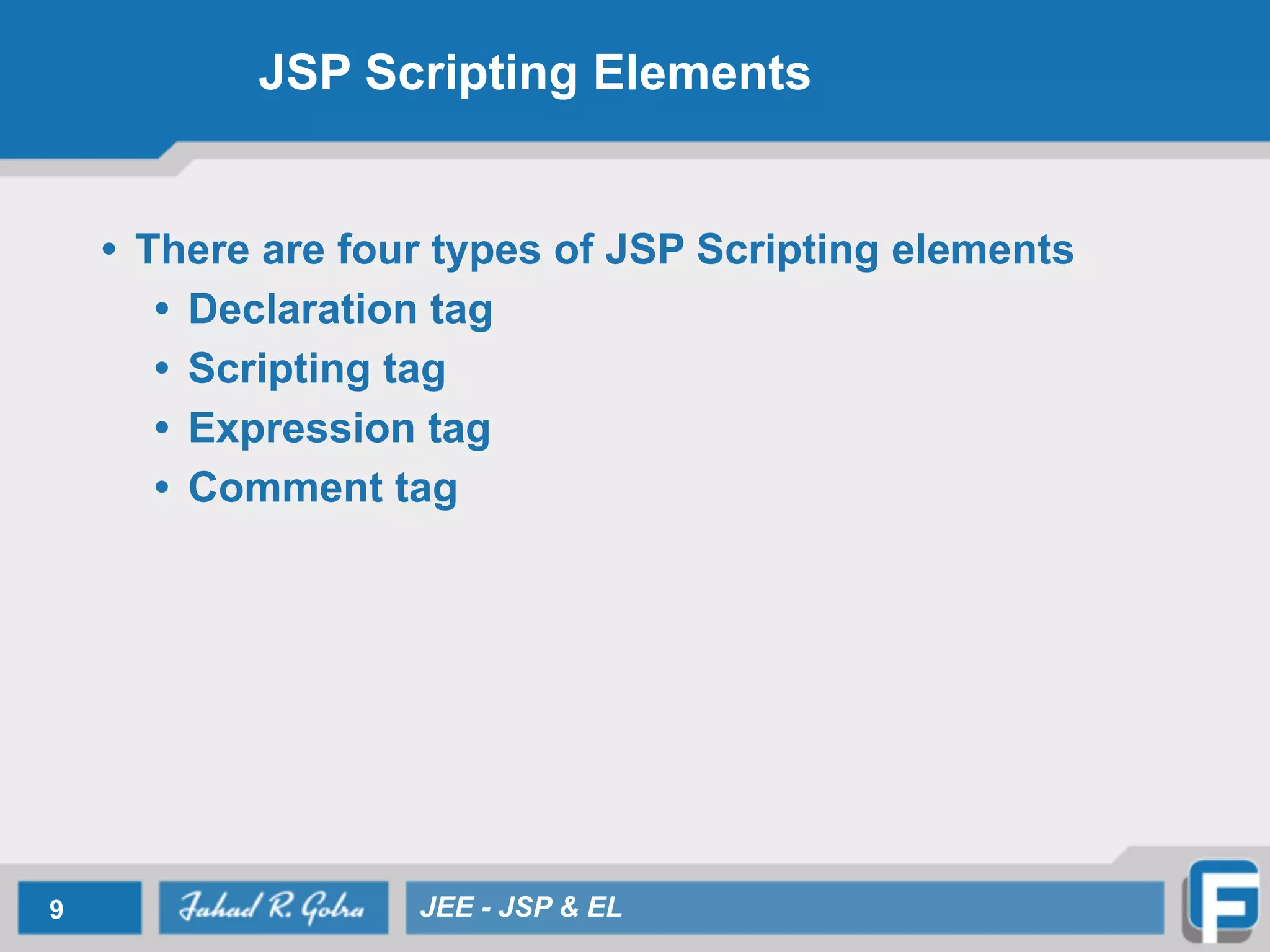
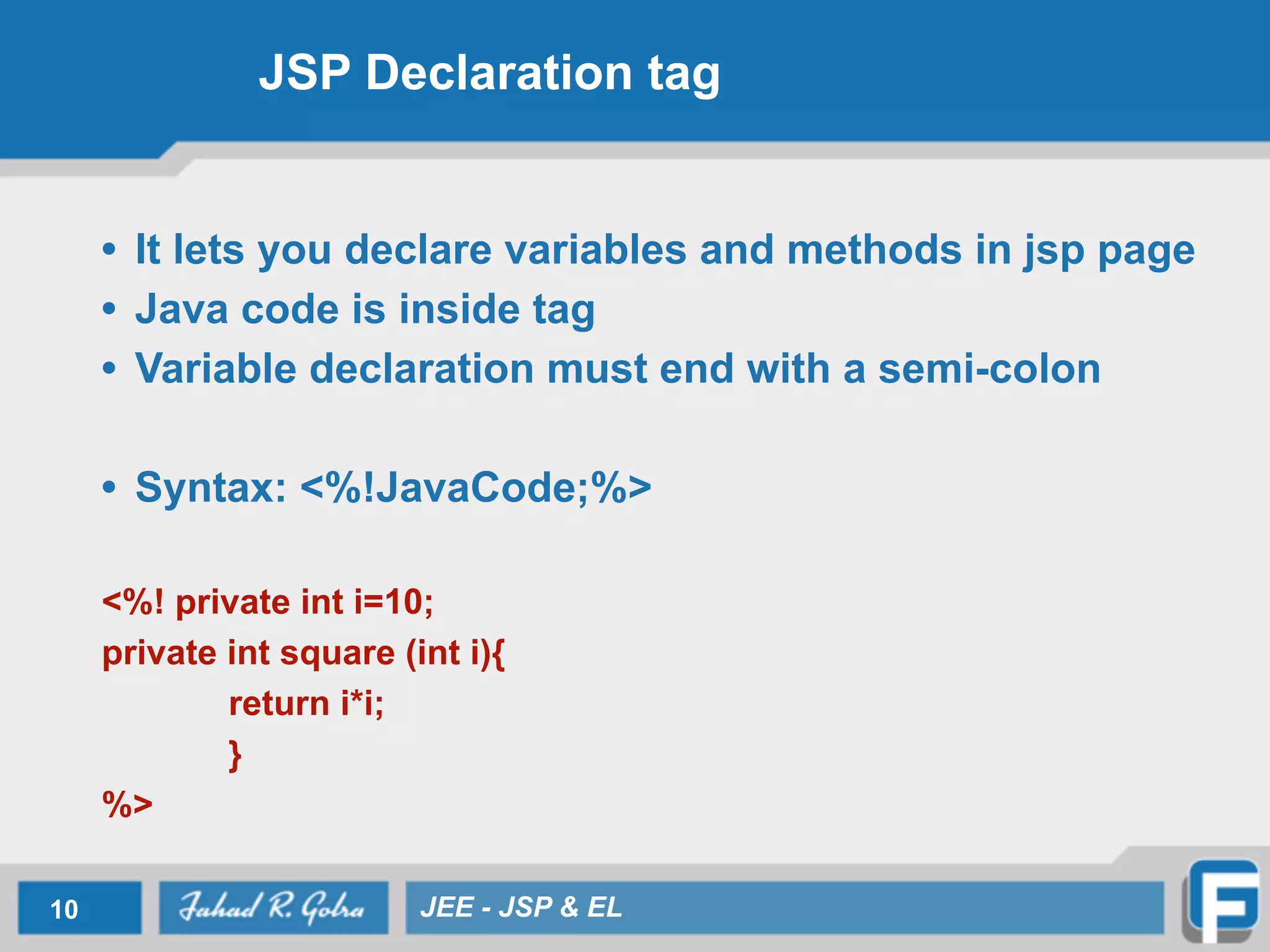
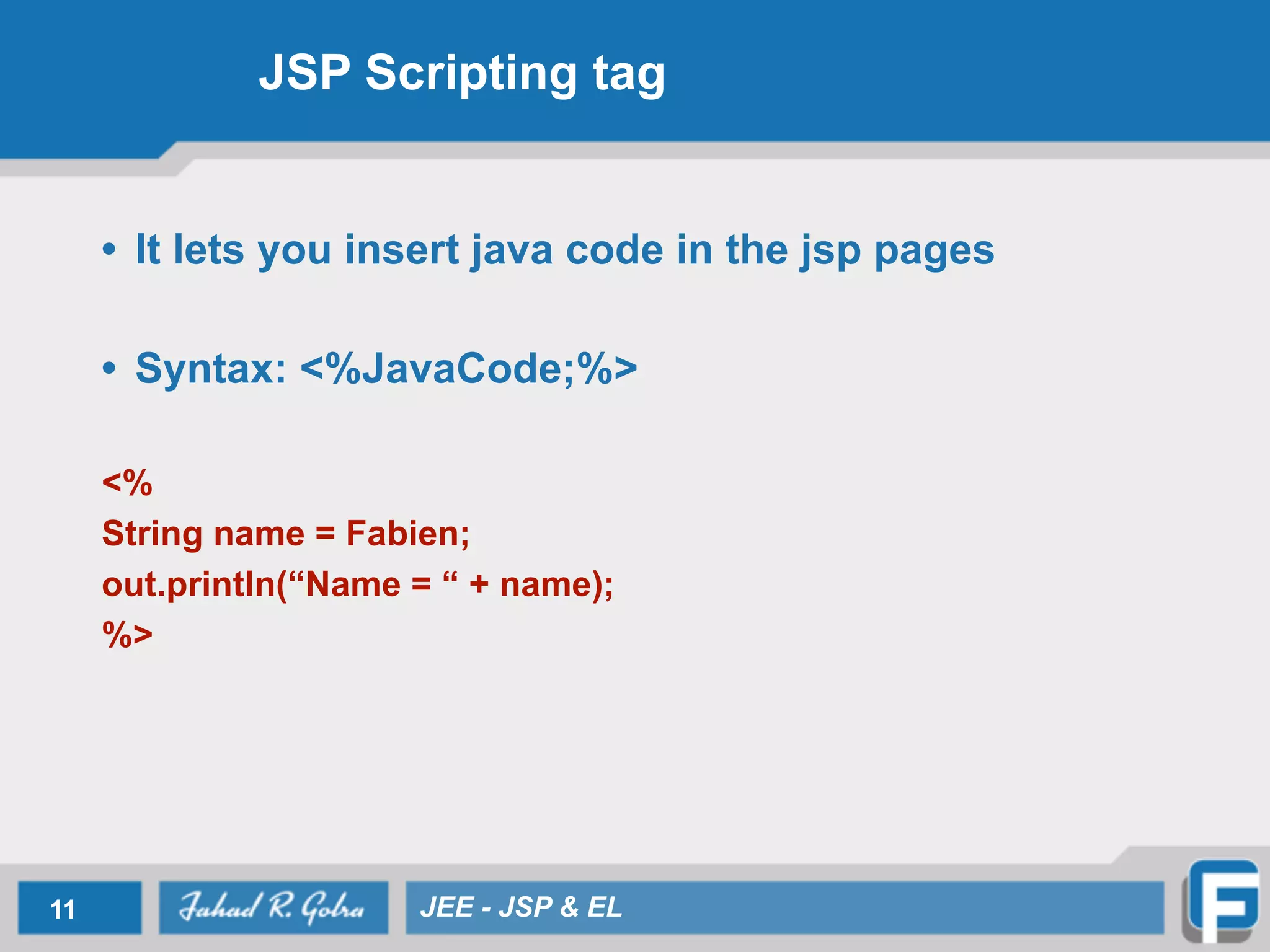
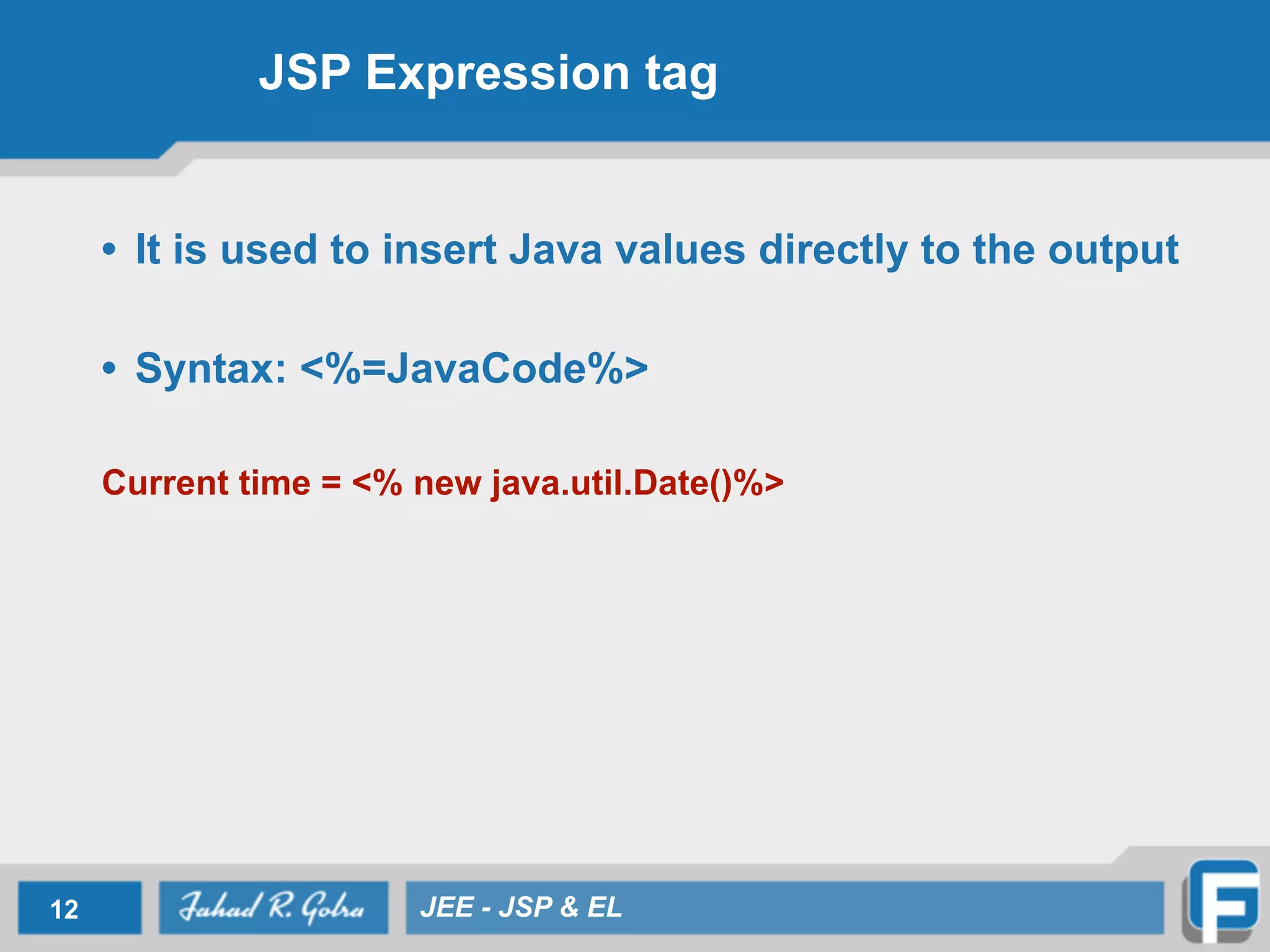
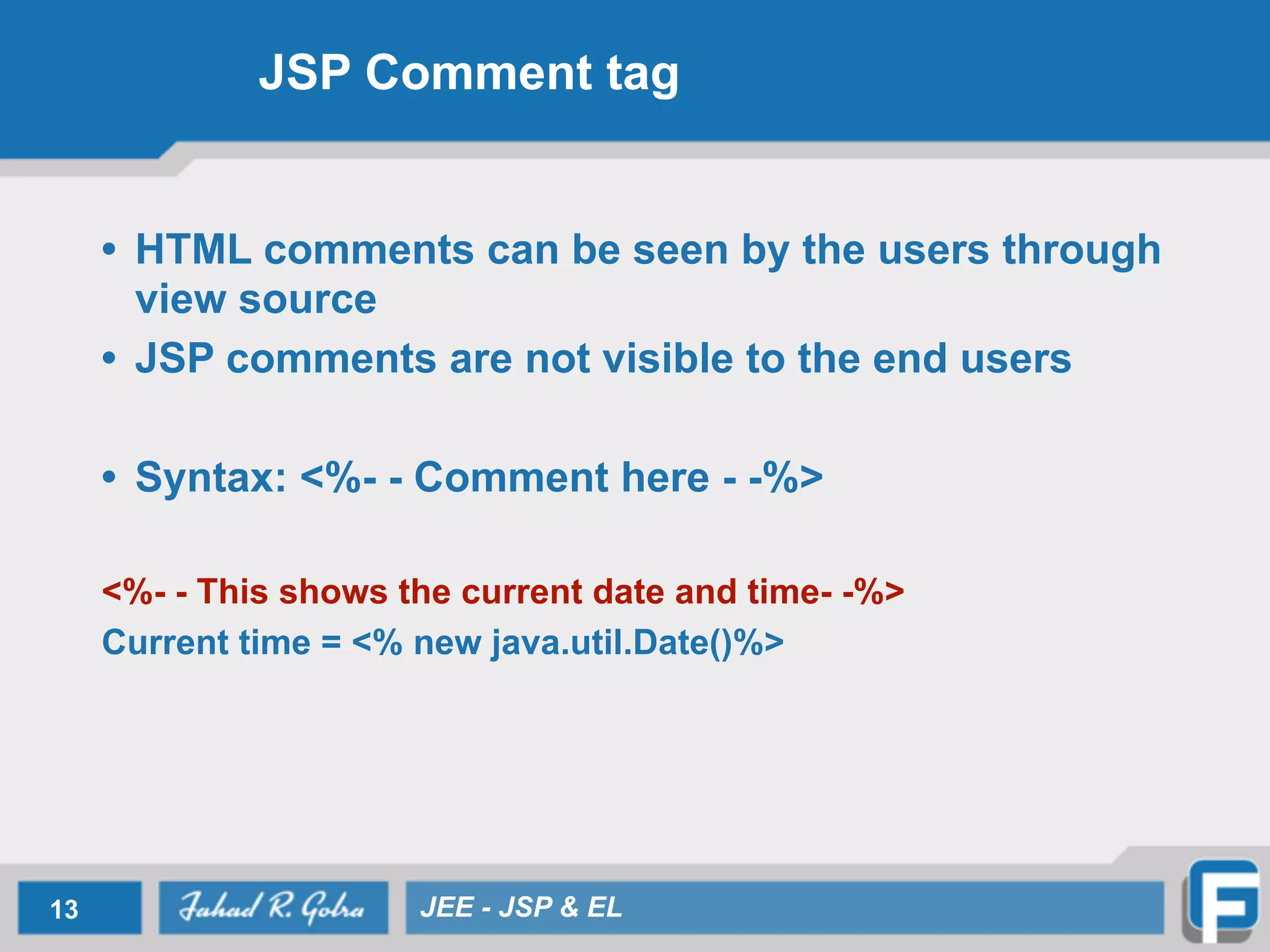
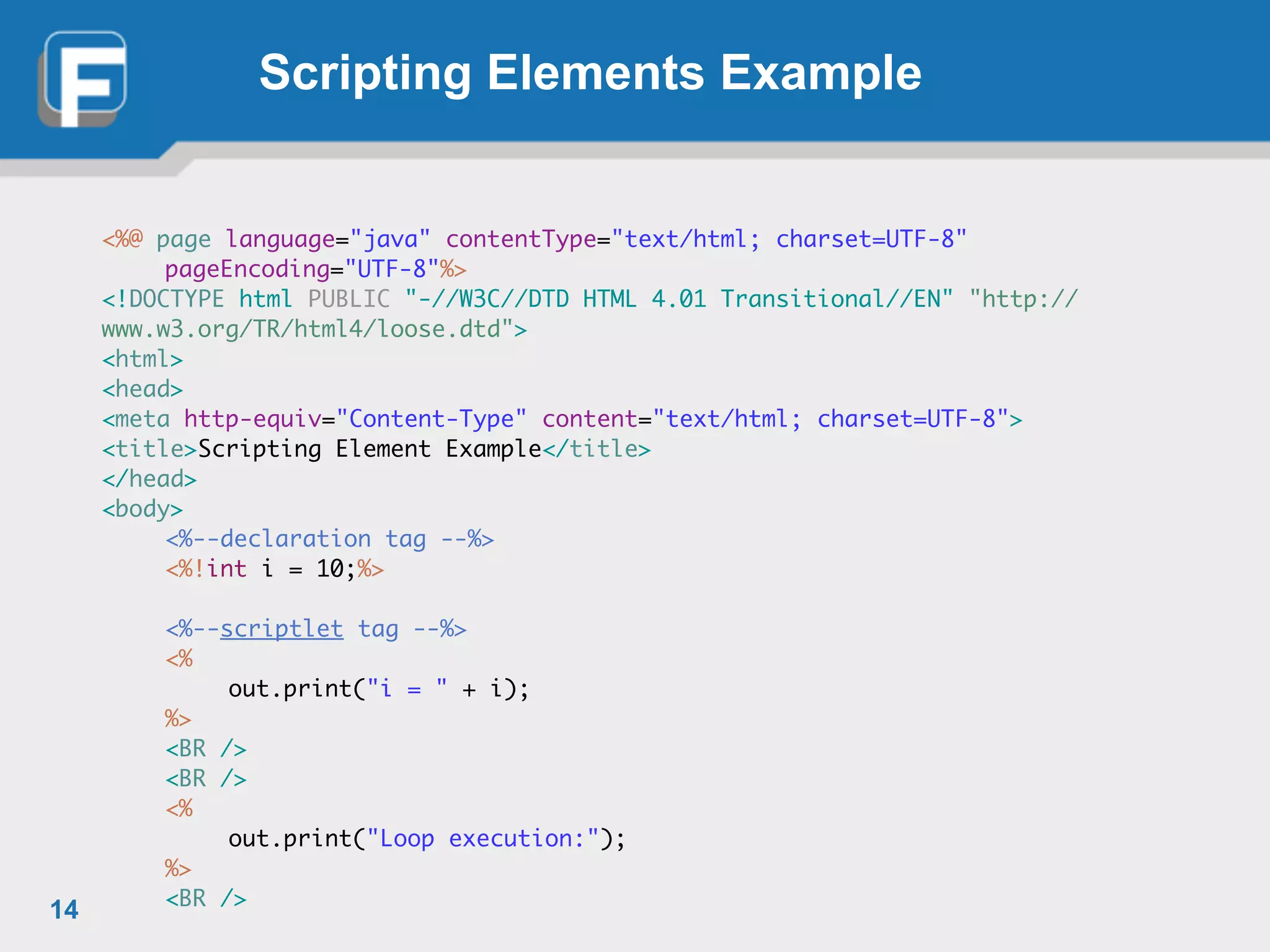
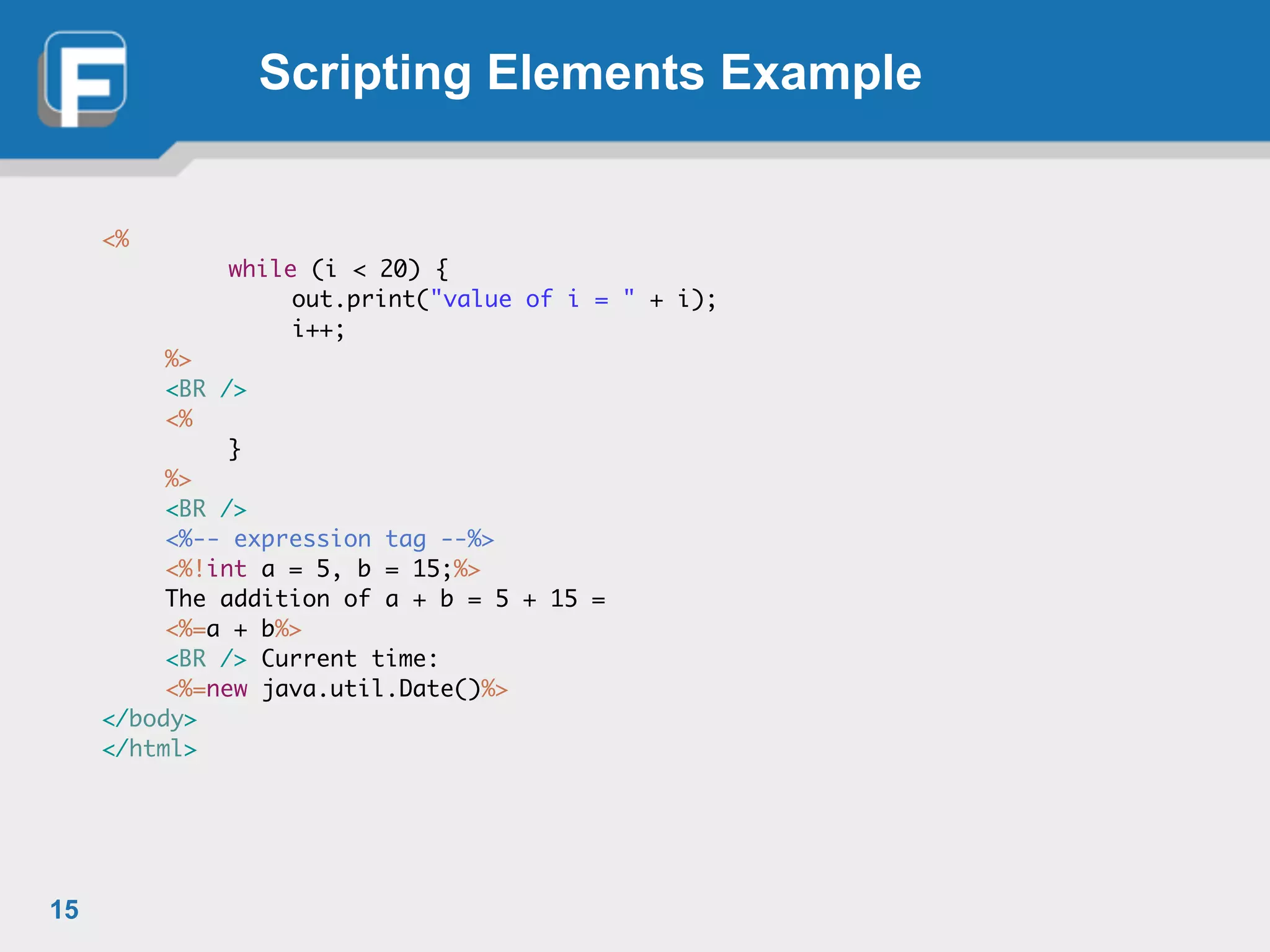
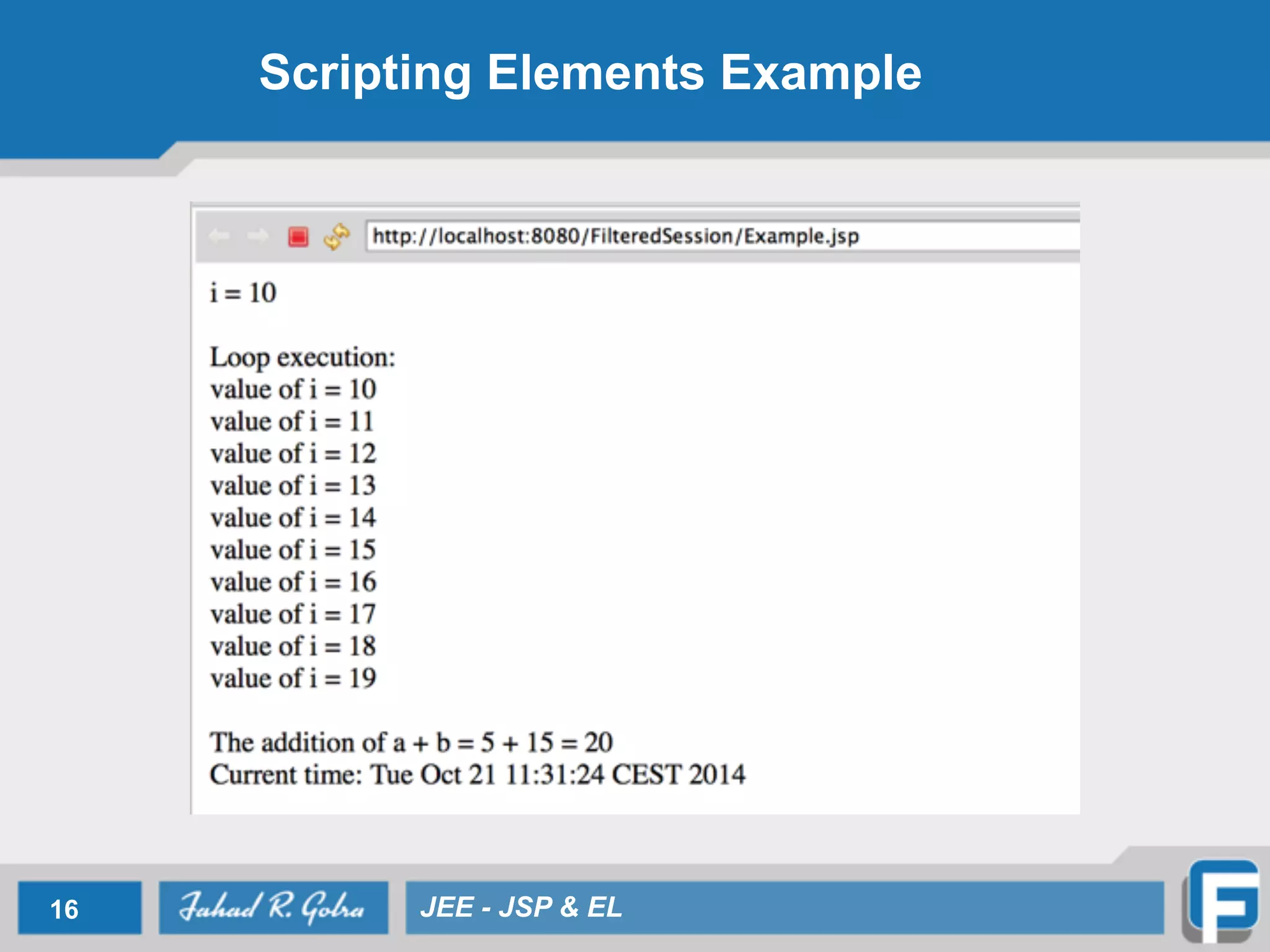
![JSP Directive Elements
• They give special information about the page to JSP
Engine
• They are handled only once at translation phase
!
• Syntax: <%@ directive-name [attribute=“value”
attribute = “value” … ]%>
!
• Types of directives
• page directive
• include directive
• taglib directive
17 JEE - JSP & EL](https://image.slidesharecdn.com/lecture4-jspel-141024065534-conversion-gate01/75/Lecture-4-JavaServer-Pages-JSP-Expression-Language-EL-17-2048.jpg)
![Page directive
• It is used to specify attributes for the JSP page
• e.g. making session data unavailable to a page
!
!
• Syntax:
<%@ page [attribute=“value” attribute = “value” … ] %>
!
• Example:
<%@ page language=“java” session=“true” … %>
18 JEE - JSP & EL](https://image.slidesharecdn.com/lecture4-jspel-141024065534-conversion-gate01/75/Lecture-4-JavaServer-Pages-JSP-Expression-Language-EL-18-2048.jpg)

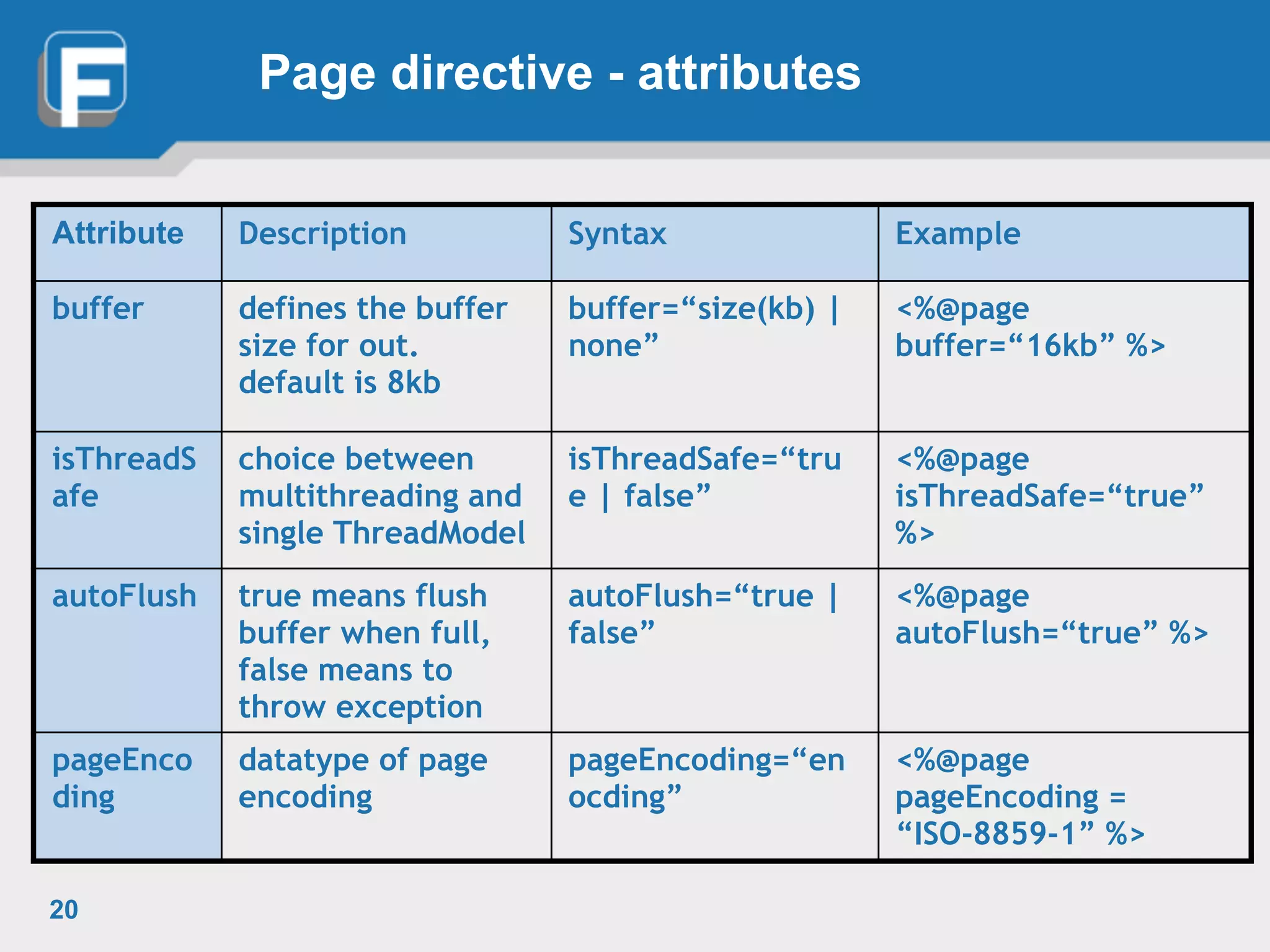
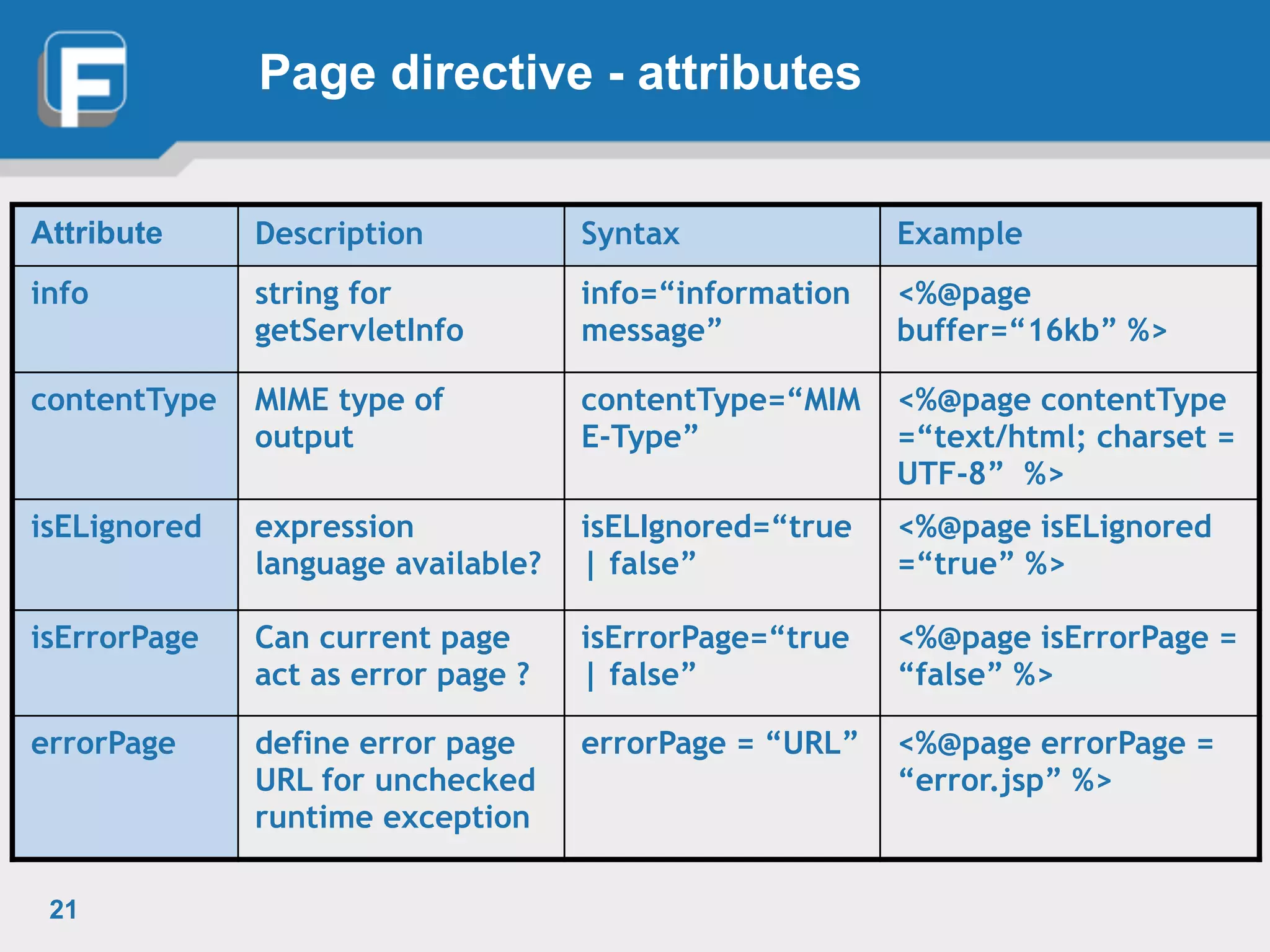
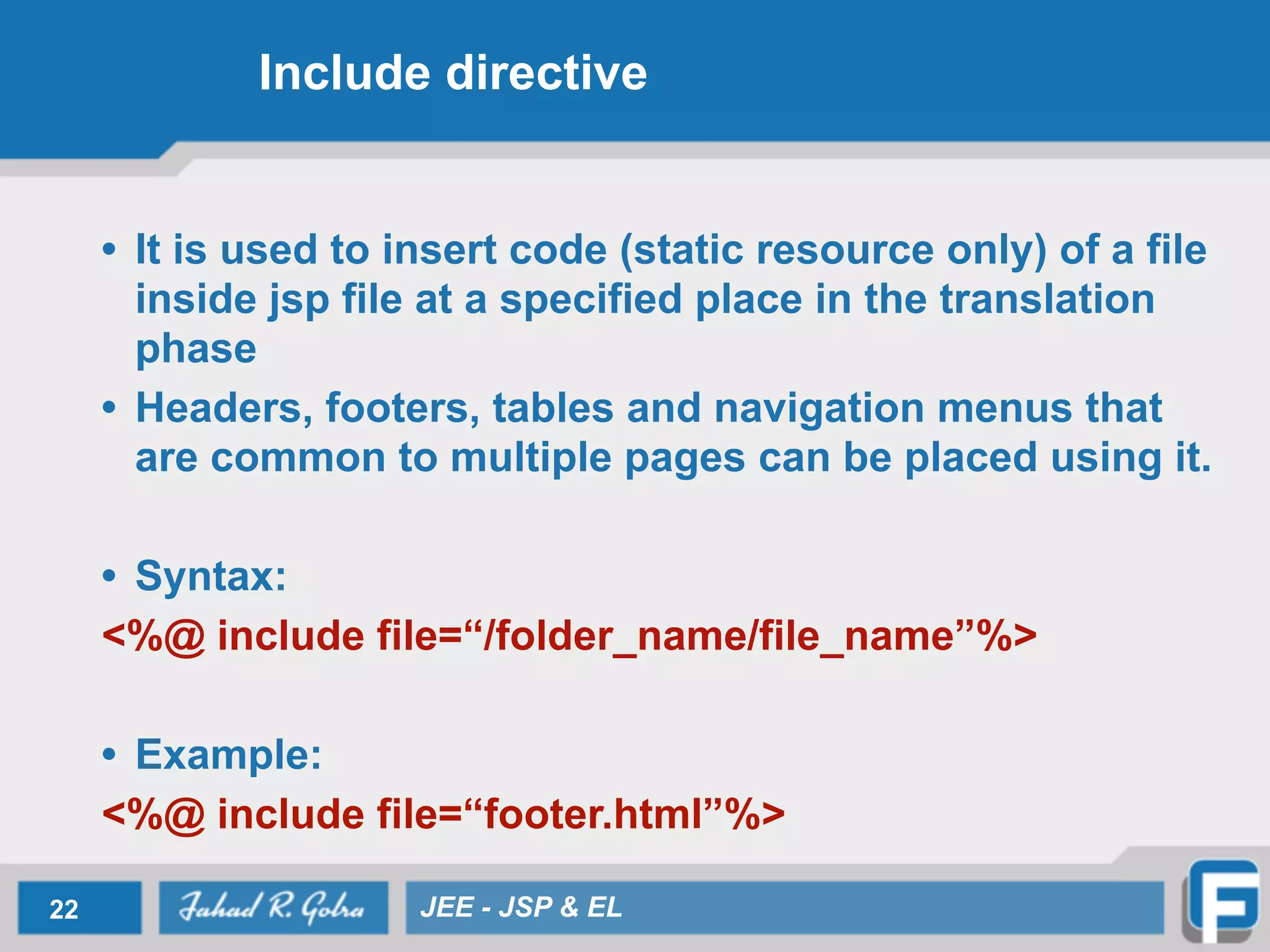

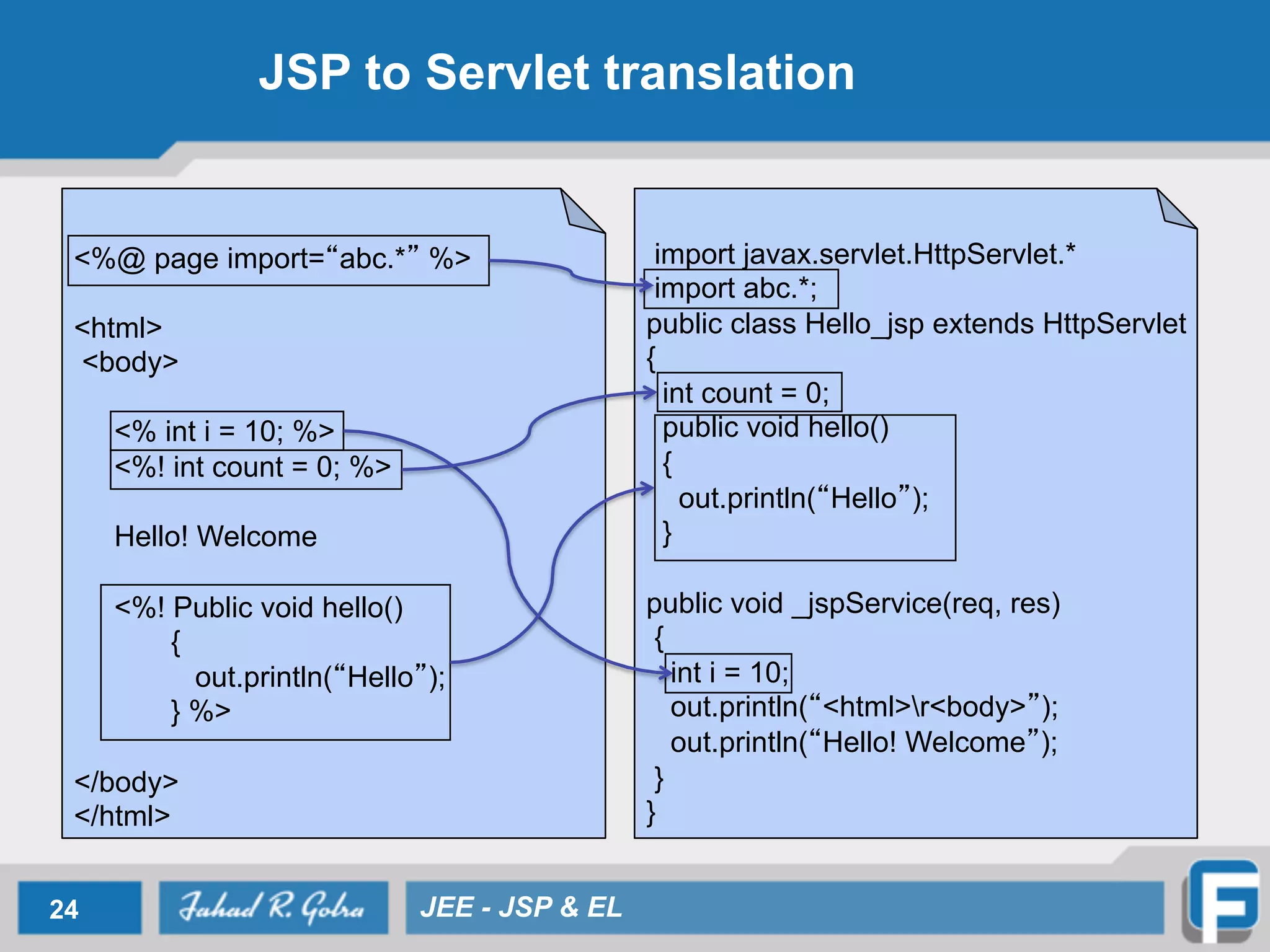
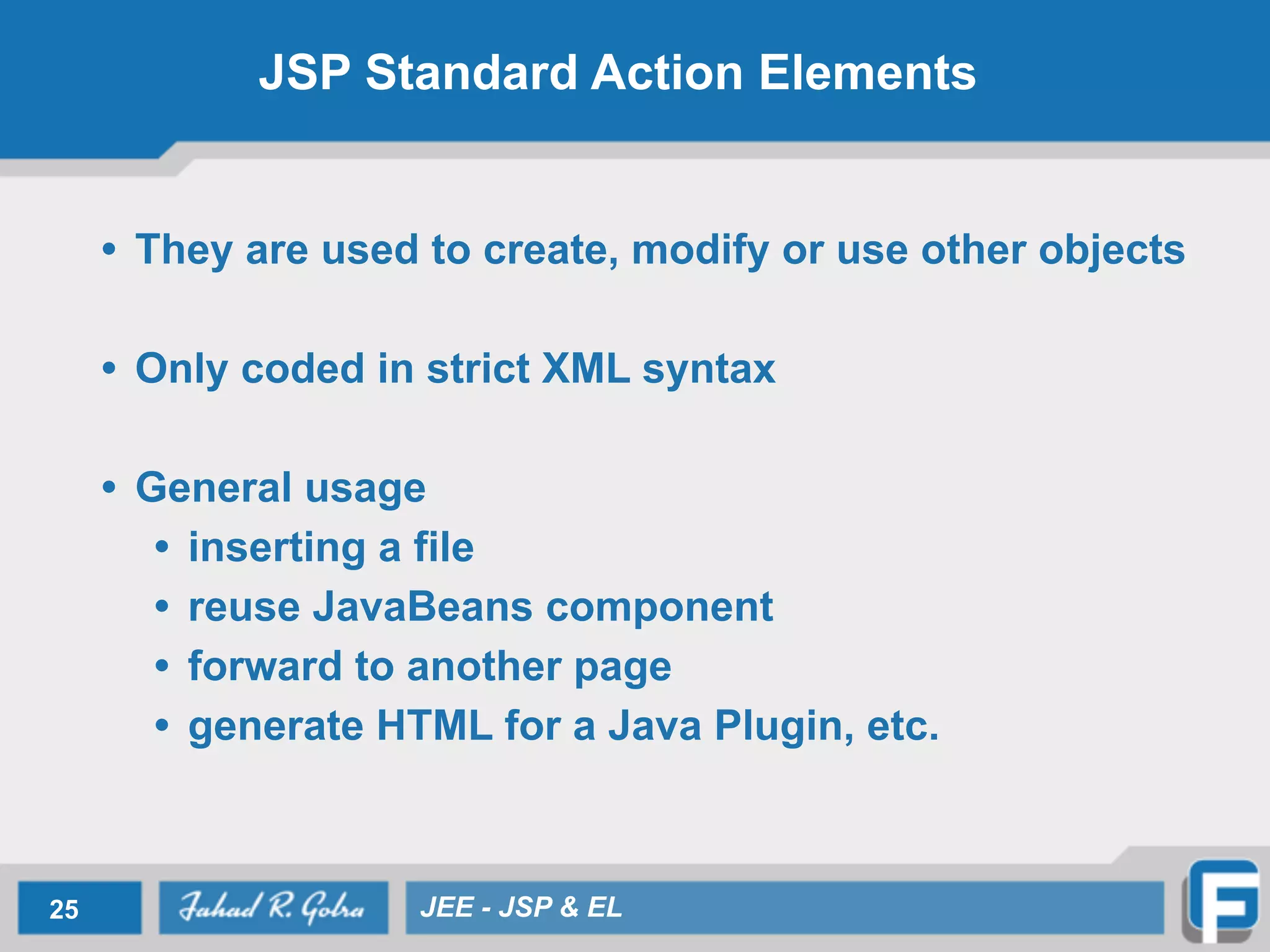
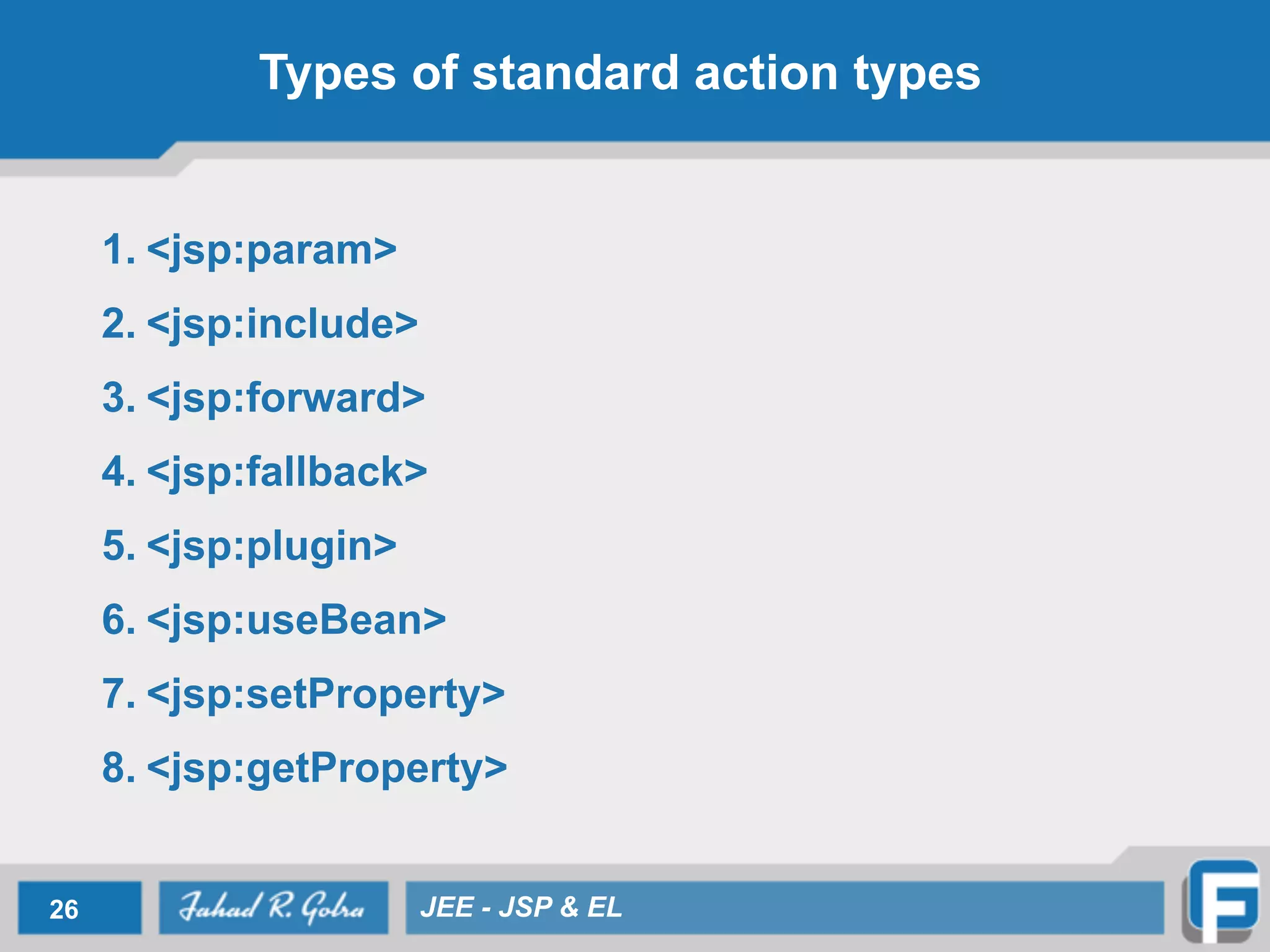

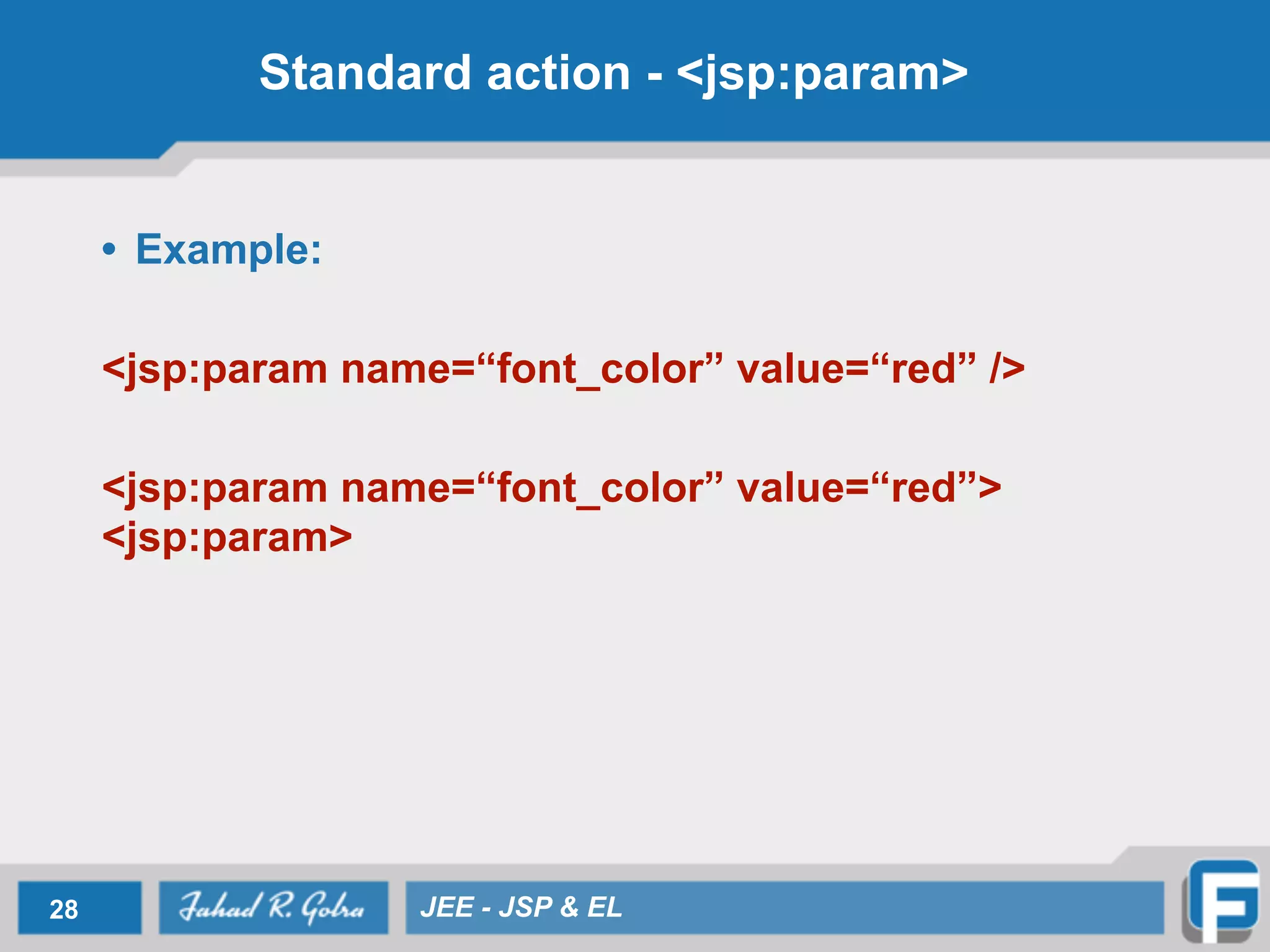
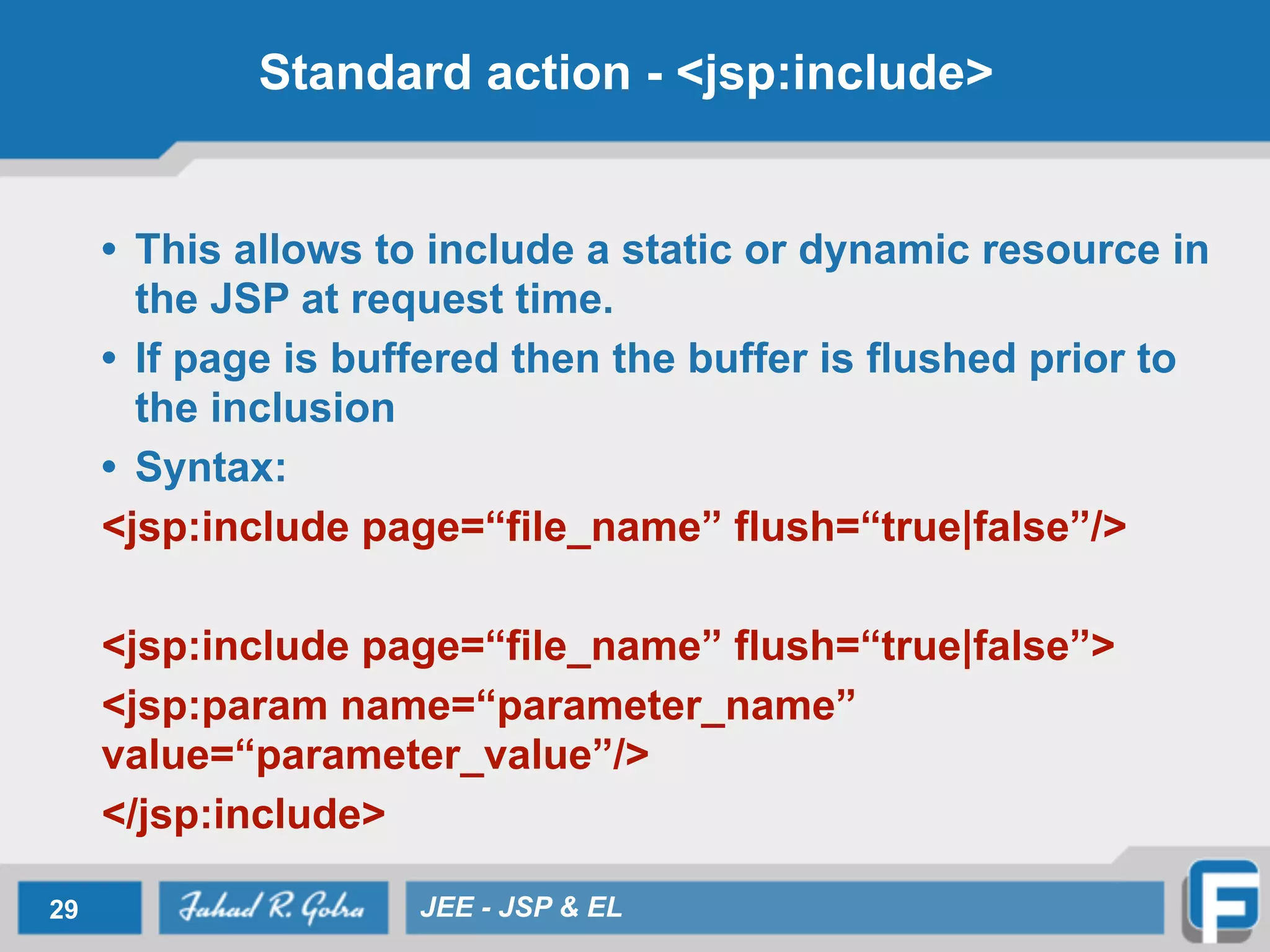
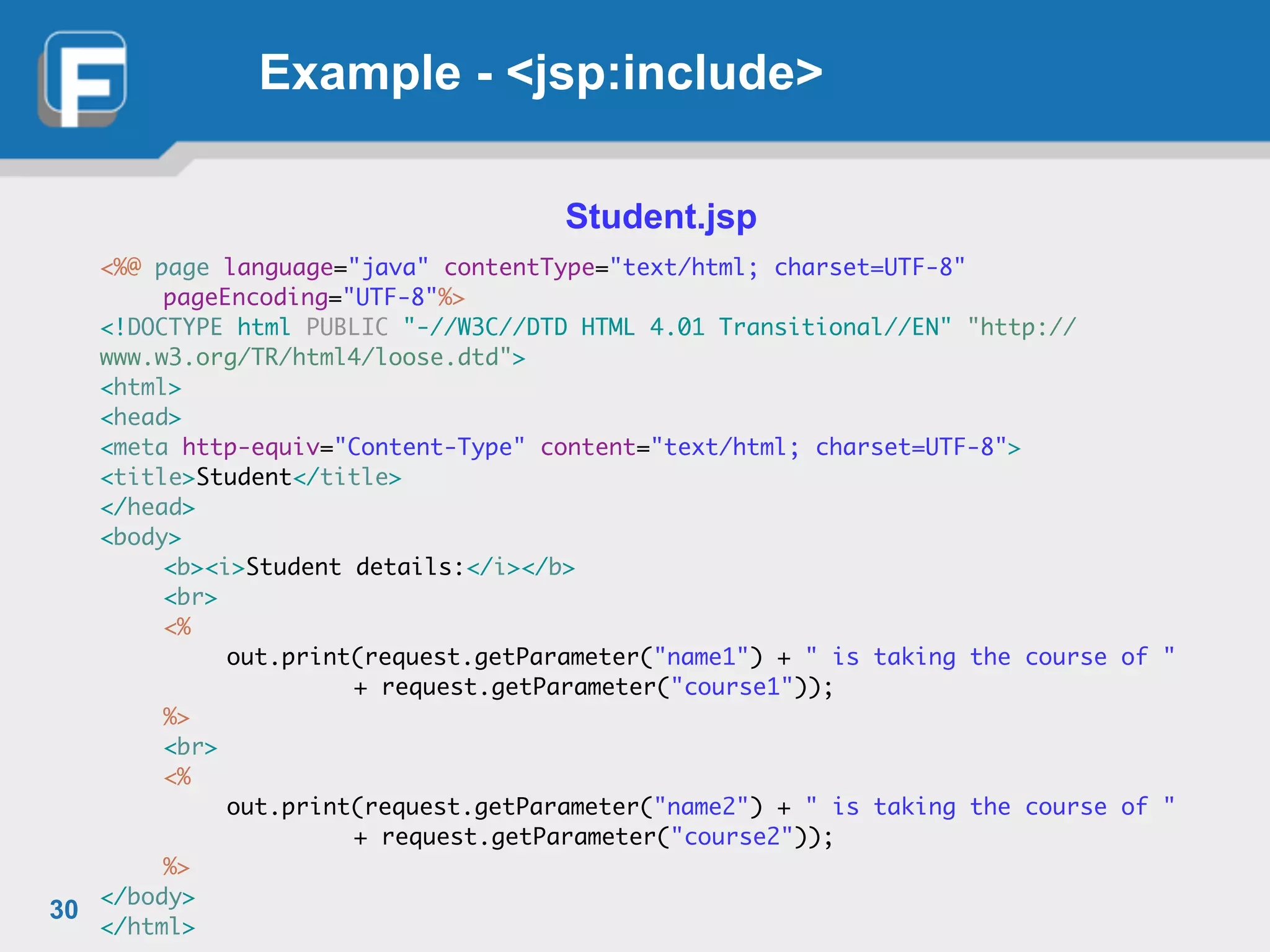
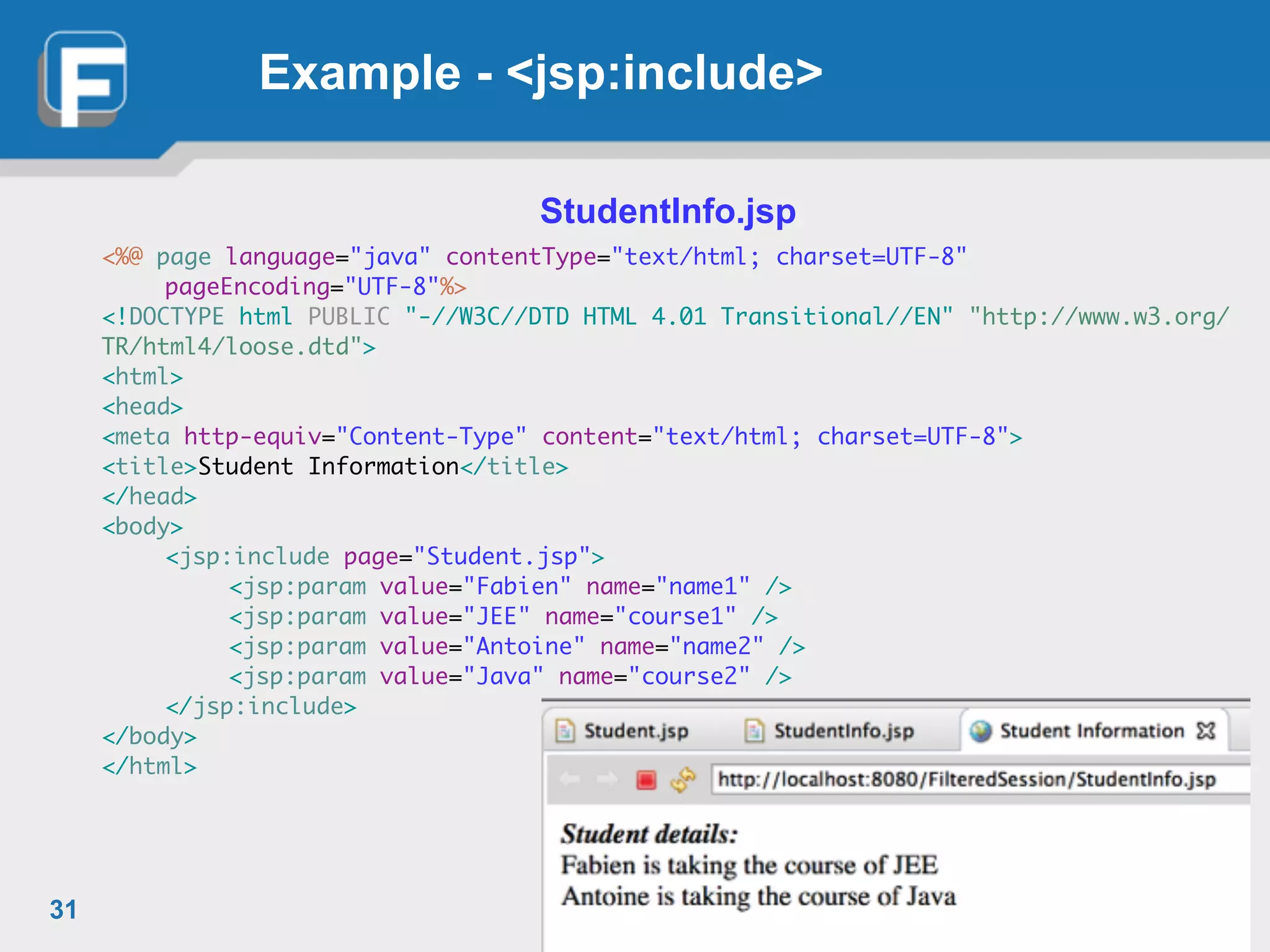
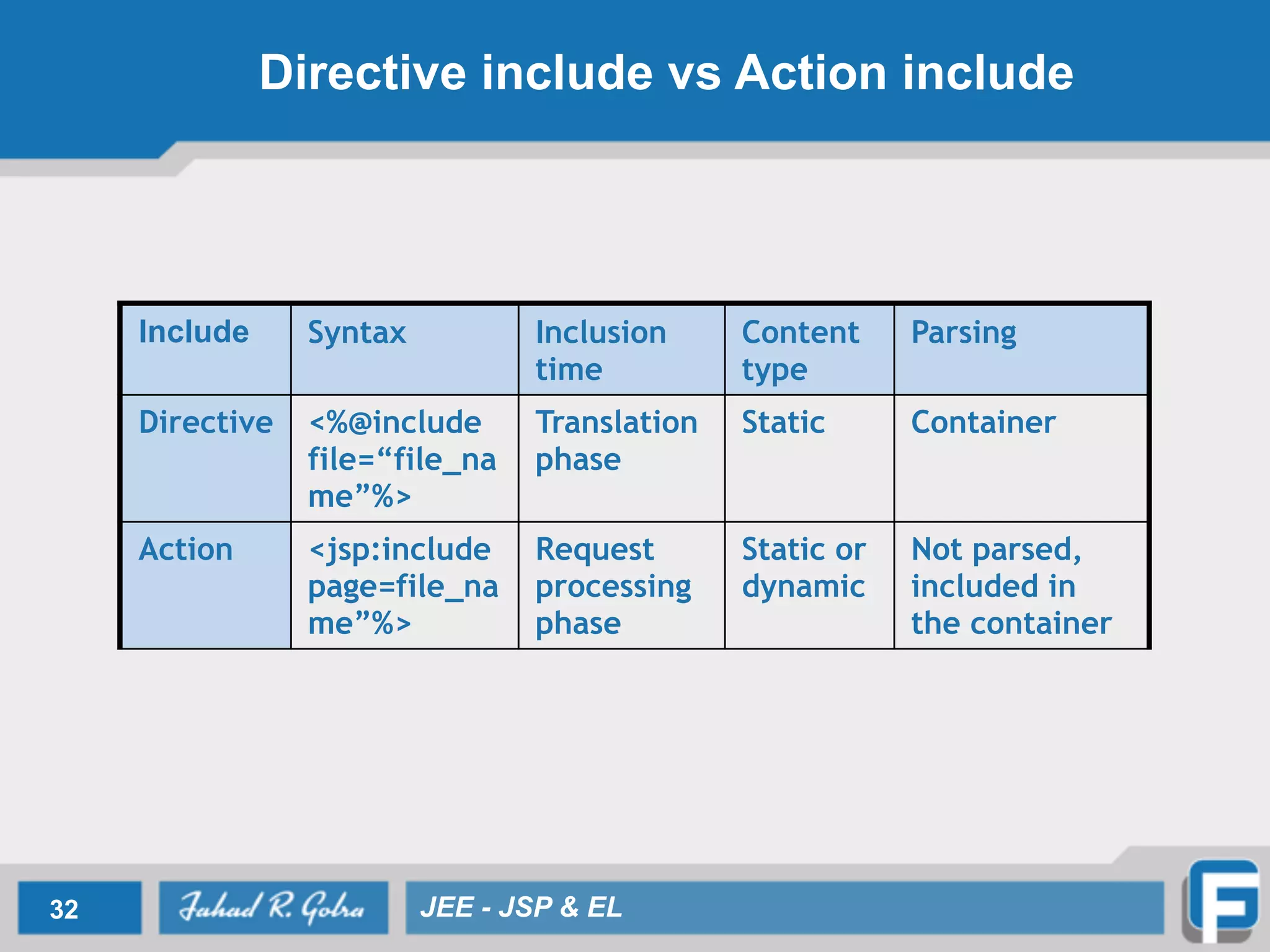
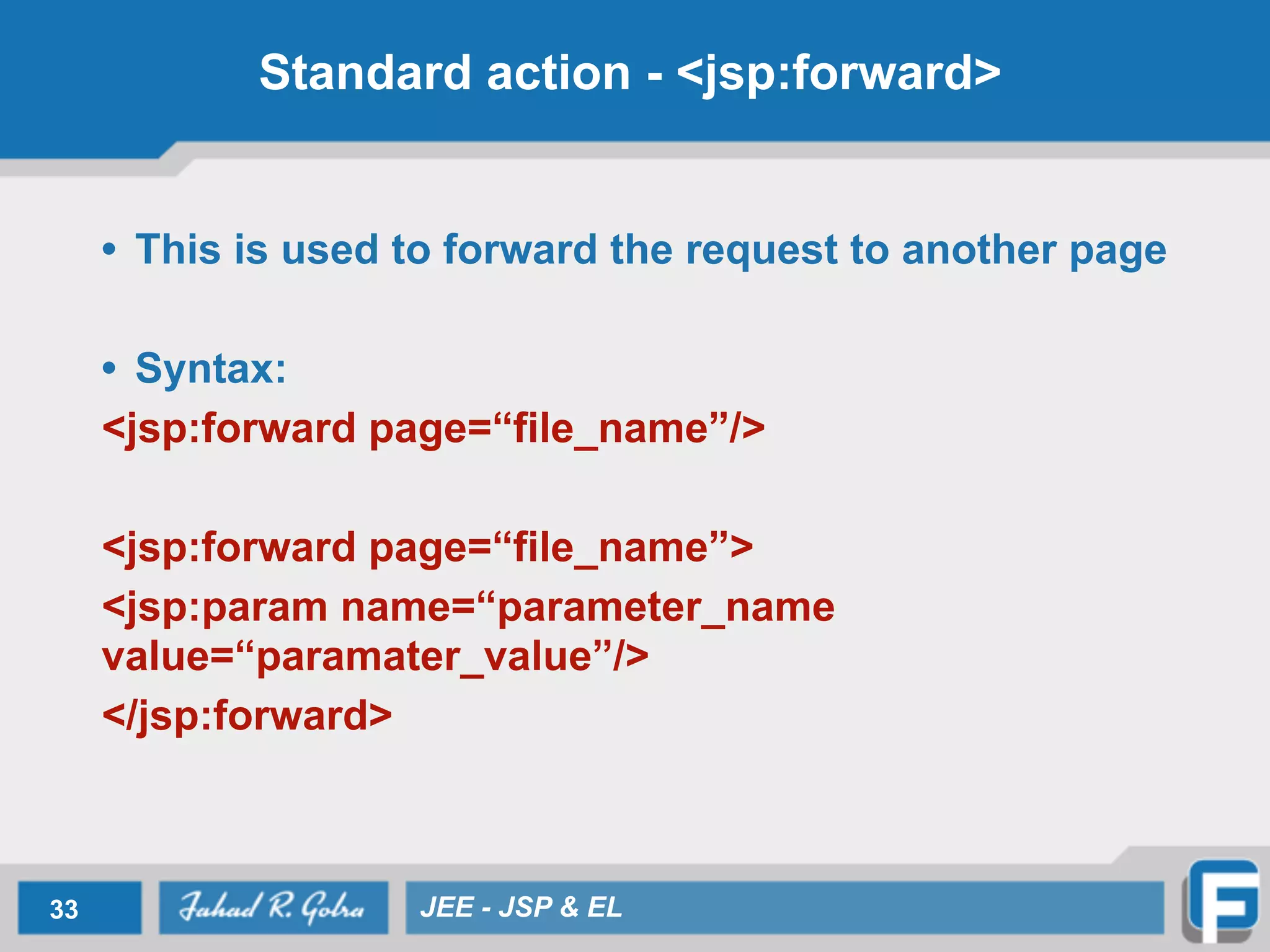
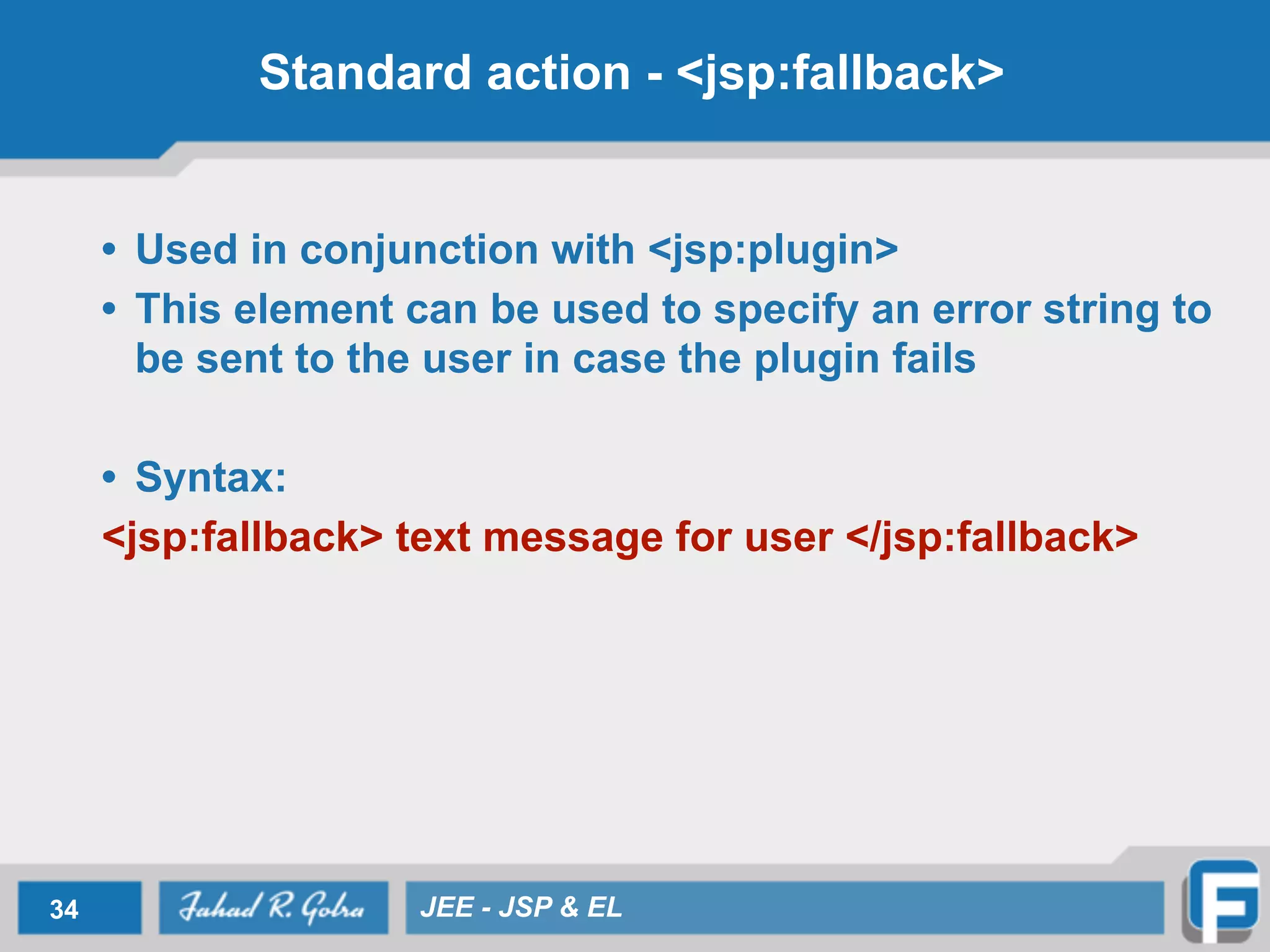
![Standard action - <jsp:plugin>
• Generates browser-specific code that makes an
Object or Embed tag for the Java plugin
• Can be used for applets and JavaBeans
• Syntax:
<jsp:plugin type=“bean|apple”
code =“className.class”
codebase=“path of className.class in WebRoot”
[name= “name of bean or applet]
[align=“bottom|top|middle|left|right]
[height:”diplayPixels”] ….. >
35 JEE - JSP & EL](https://image.slidesharecdn.com/lecture4-jspel-141024065534-conversion-gate01/75/Lecture-4-JavaServer-Pages-JSP-Expression-Language-EL-35-2048.jpg)
![Standard action - <jsp:plugin>
[<jsp:params>
<jsp:param name=“parameter_name”
value=“parameter_value”/>
<jsp:param name=“parameter_name”
value=“parameter_value”/>
…….
</jsp:params>]
[<jsp:fallback> text message </jsp:fallback>]
</jsp:plugin>
36 JEE - JSP & EL](https://image.slidesharecdn.com/lecture4-jspel-141024065534-conversion-gate01/75/Lecture-4-JavaServer-Pages-JSP-Expression-Language-EL-36-2048.jpg)
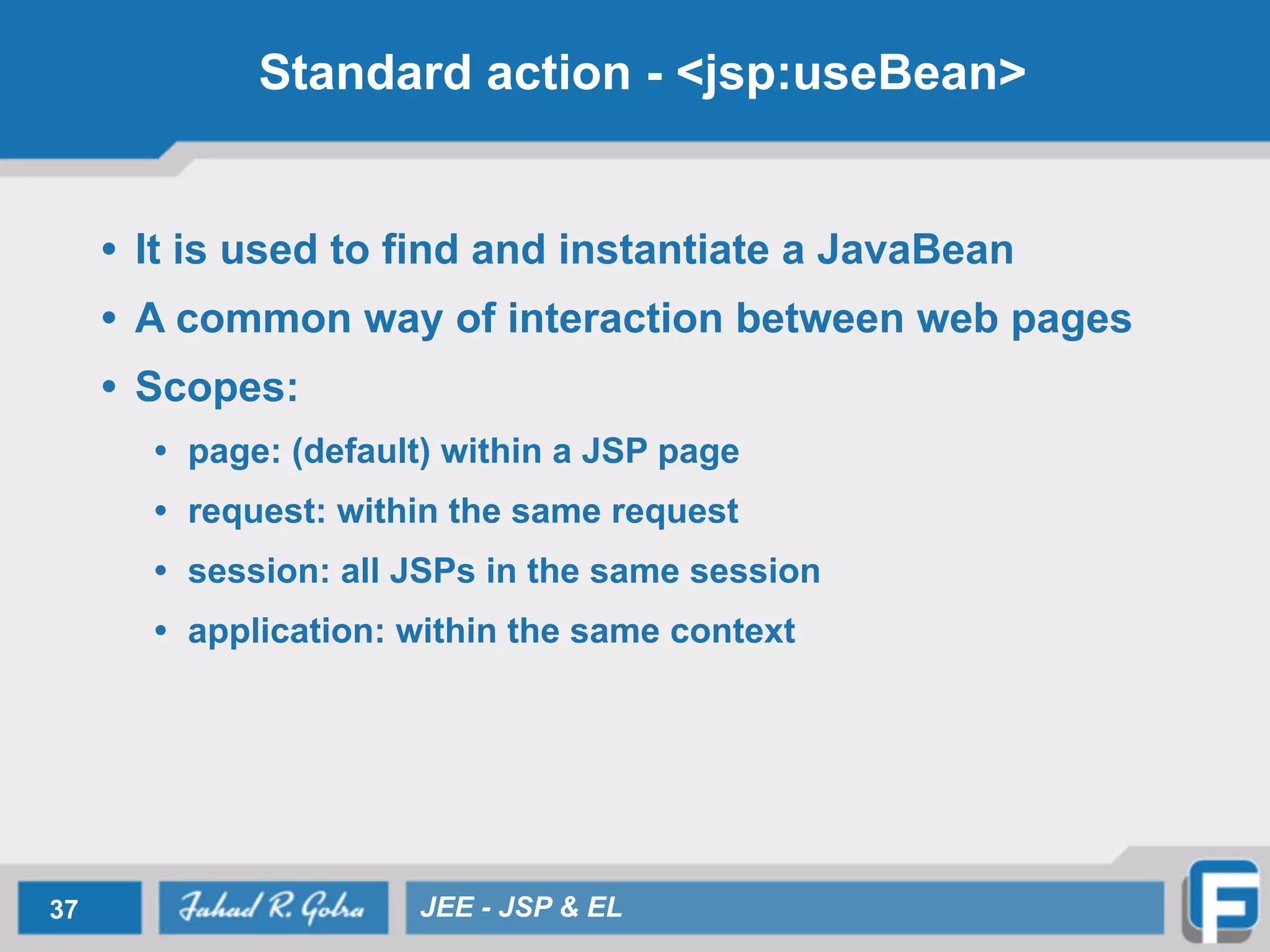
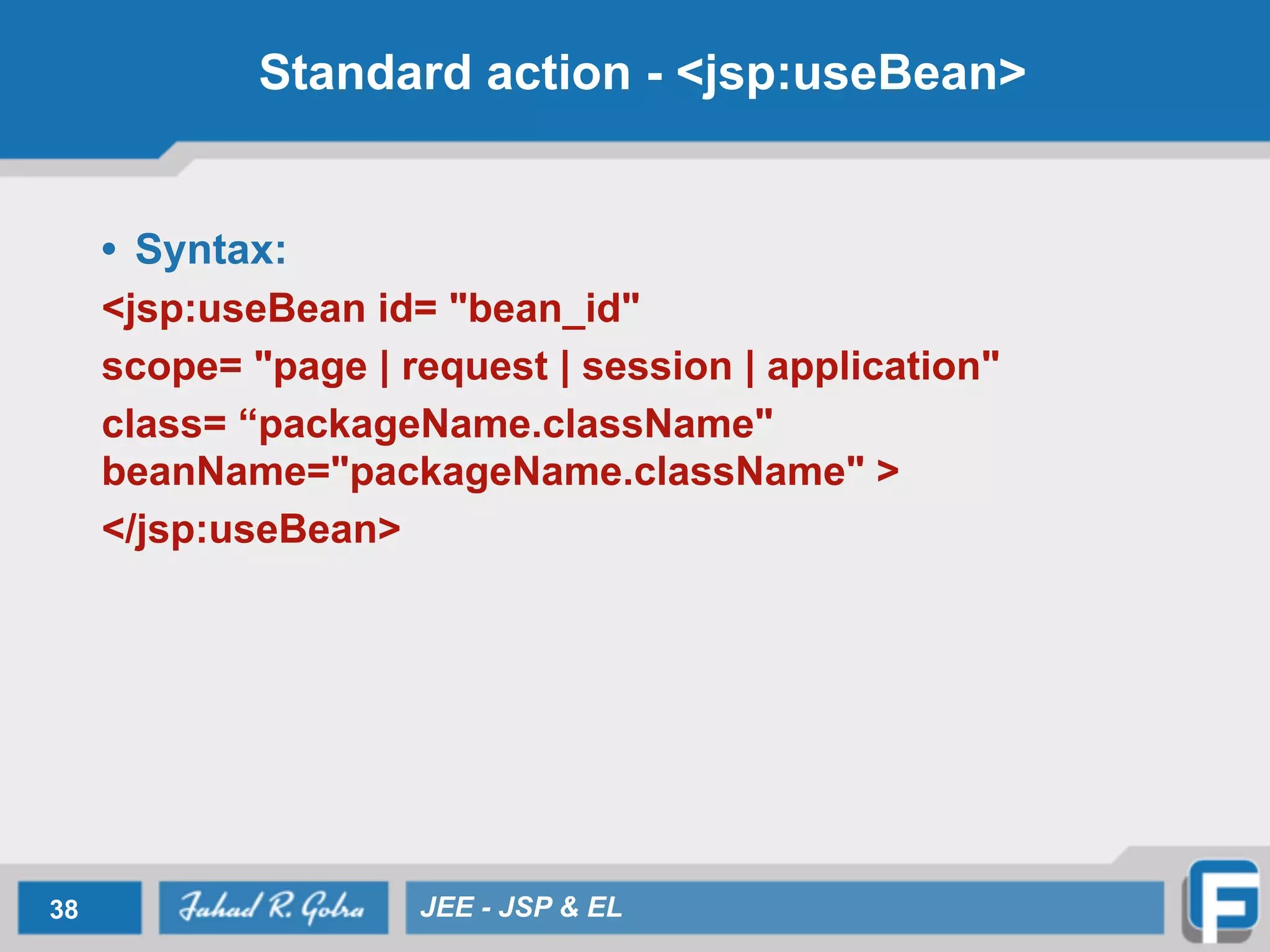
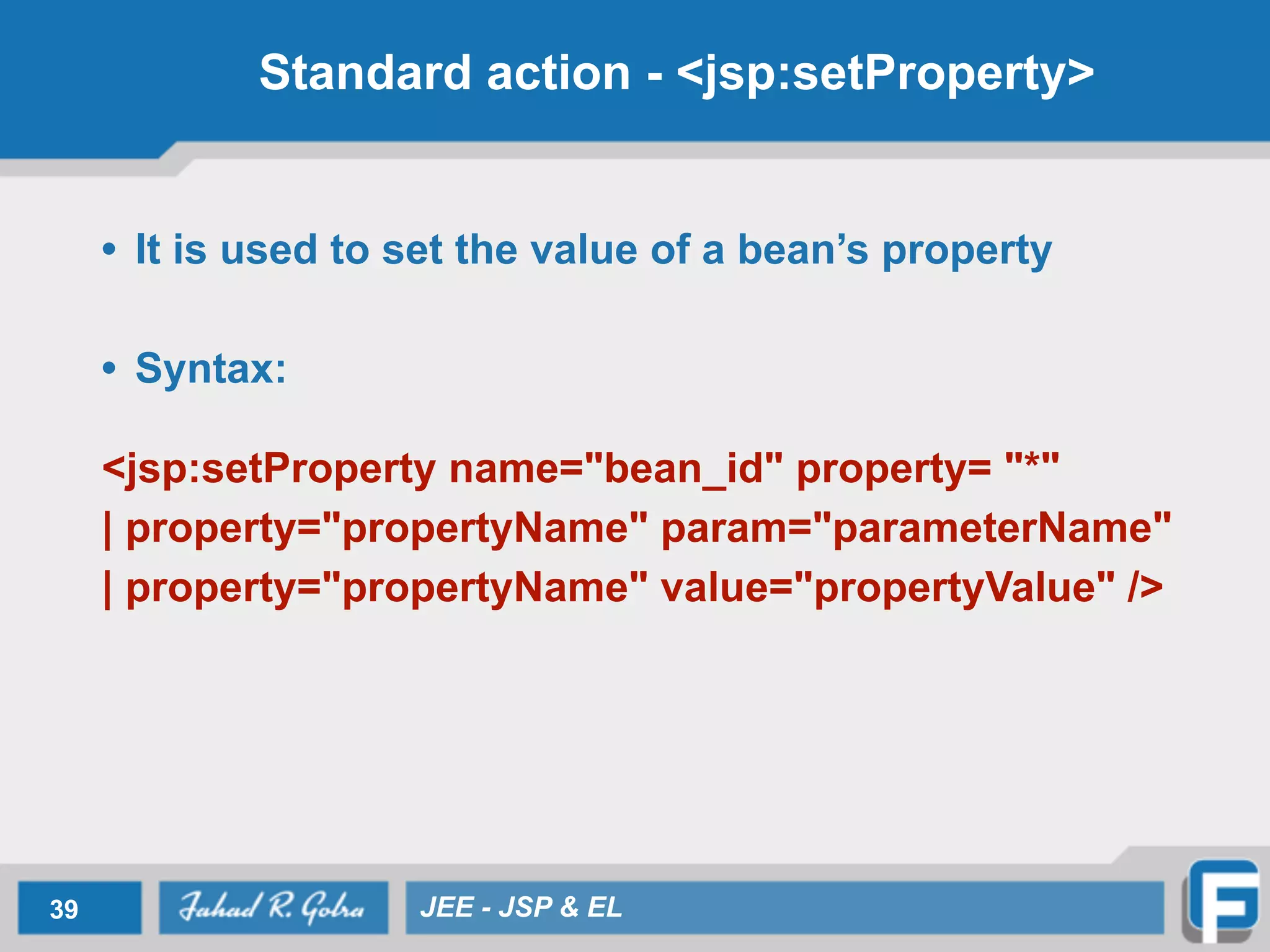
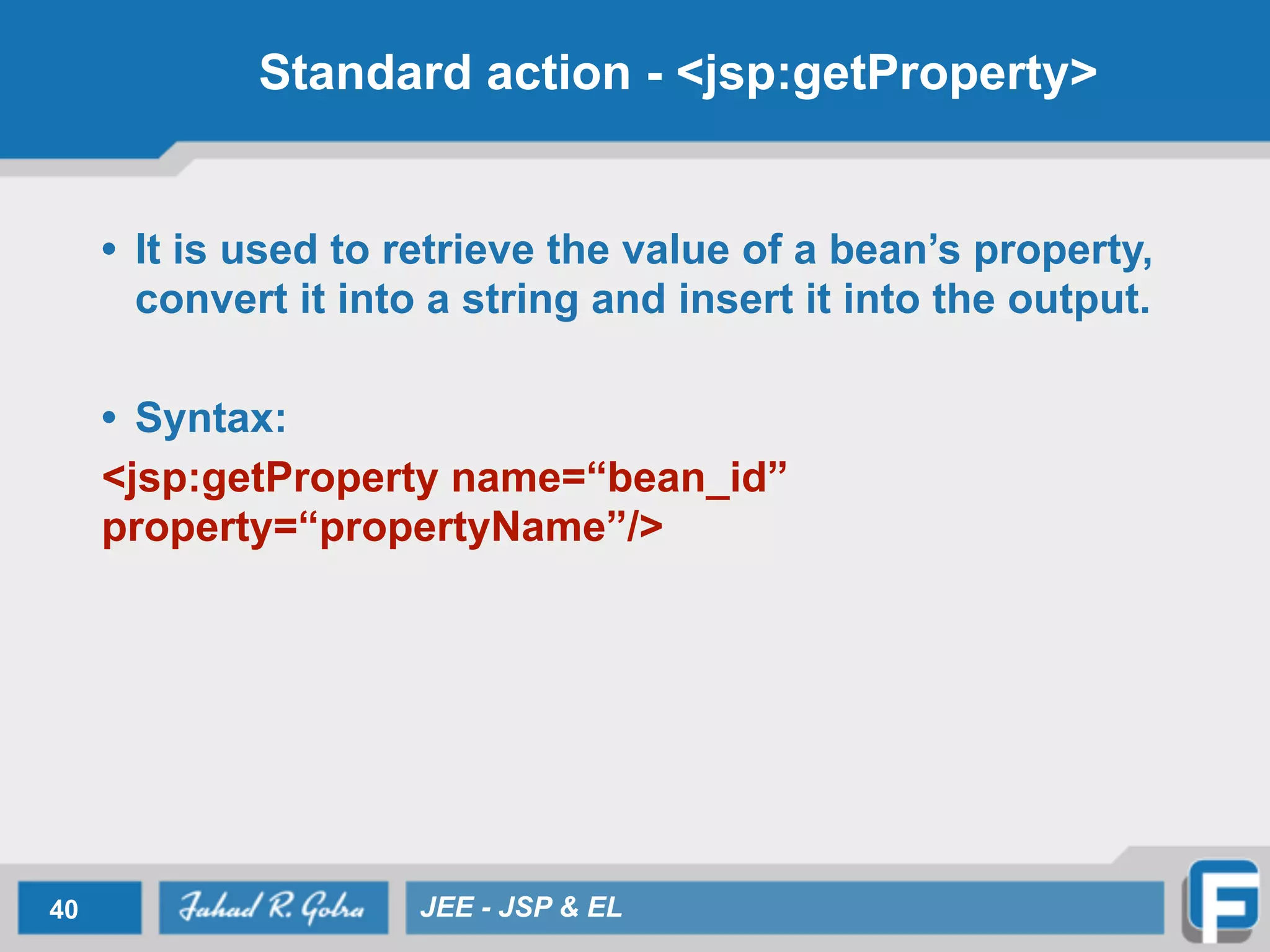
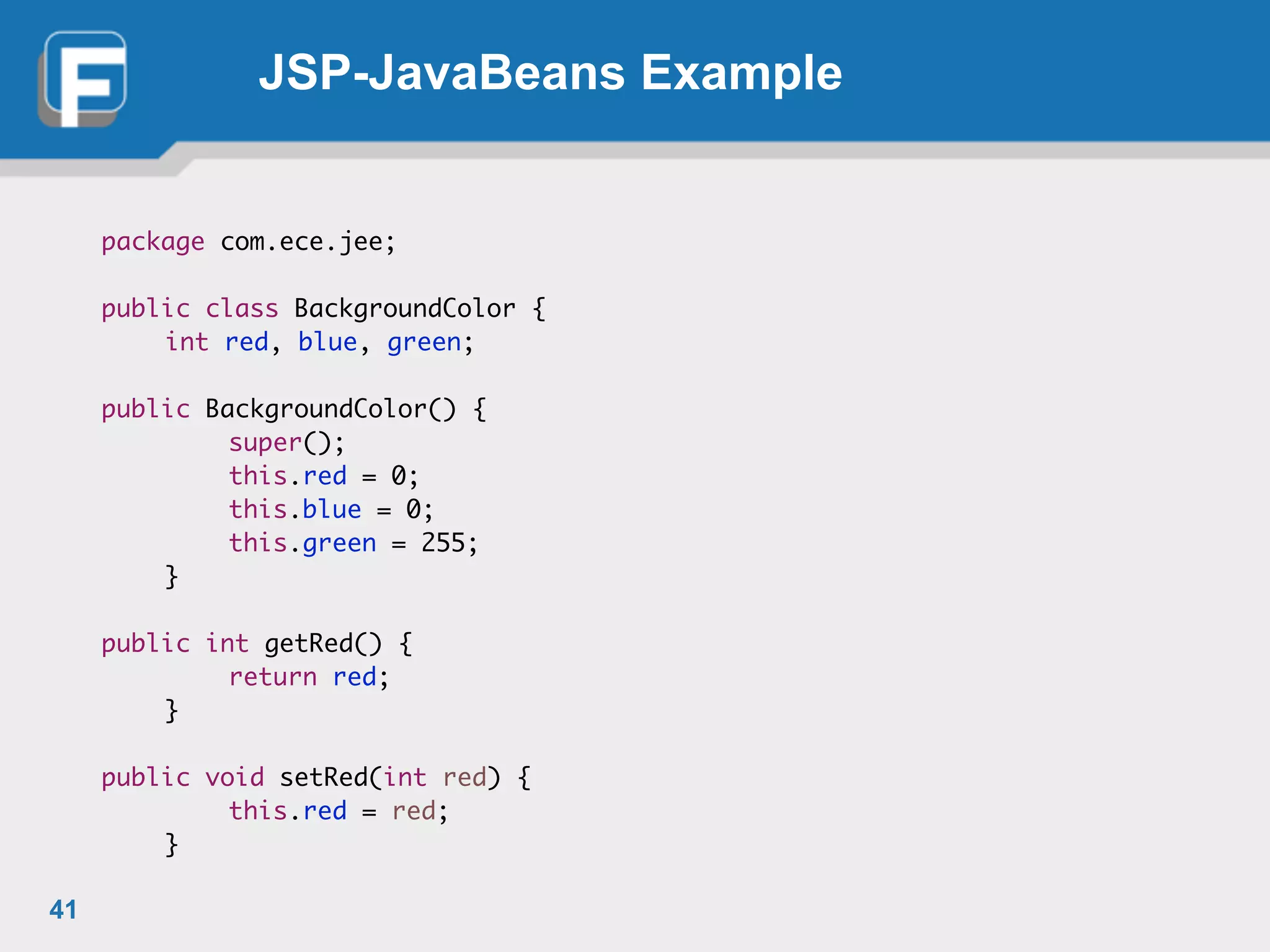
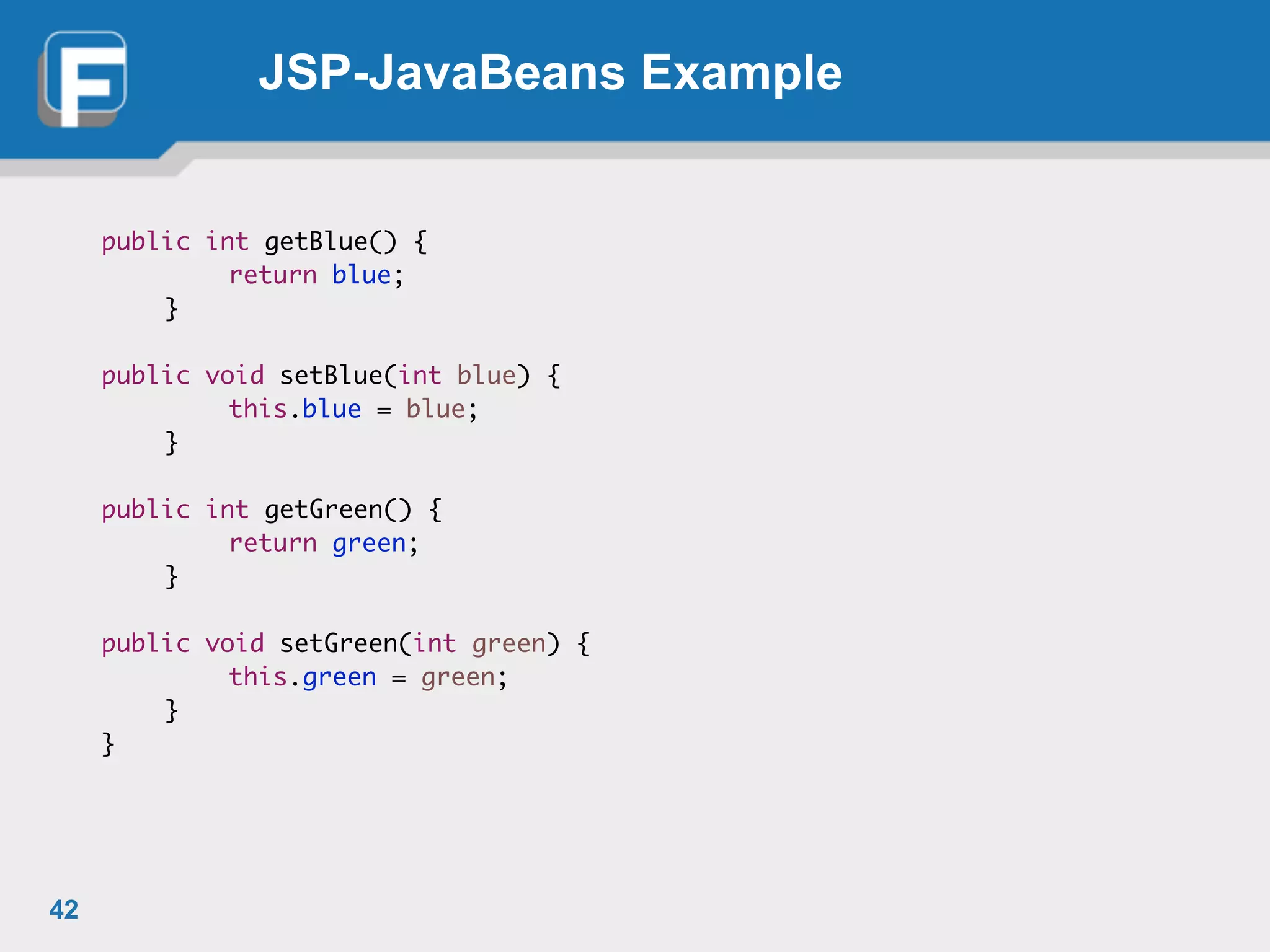
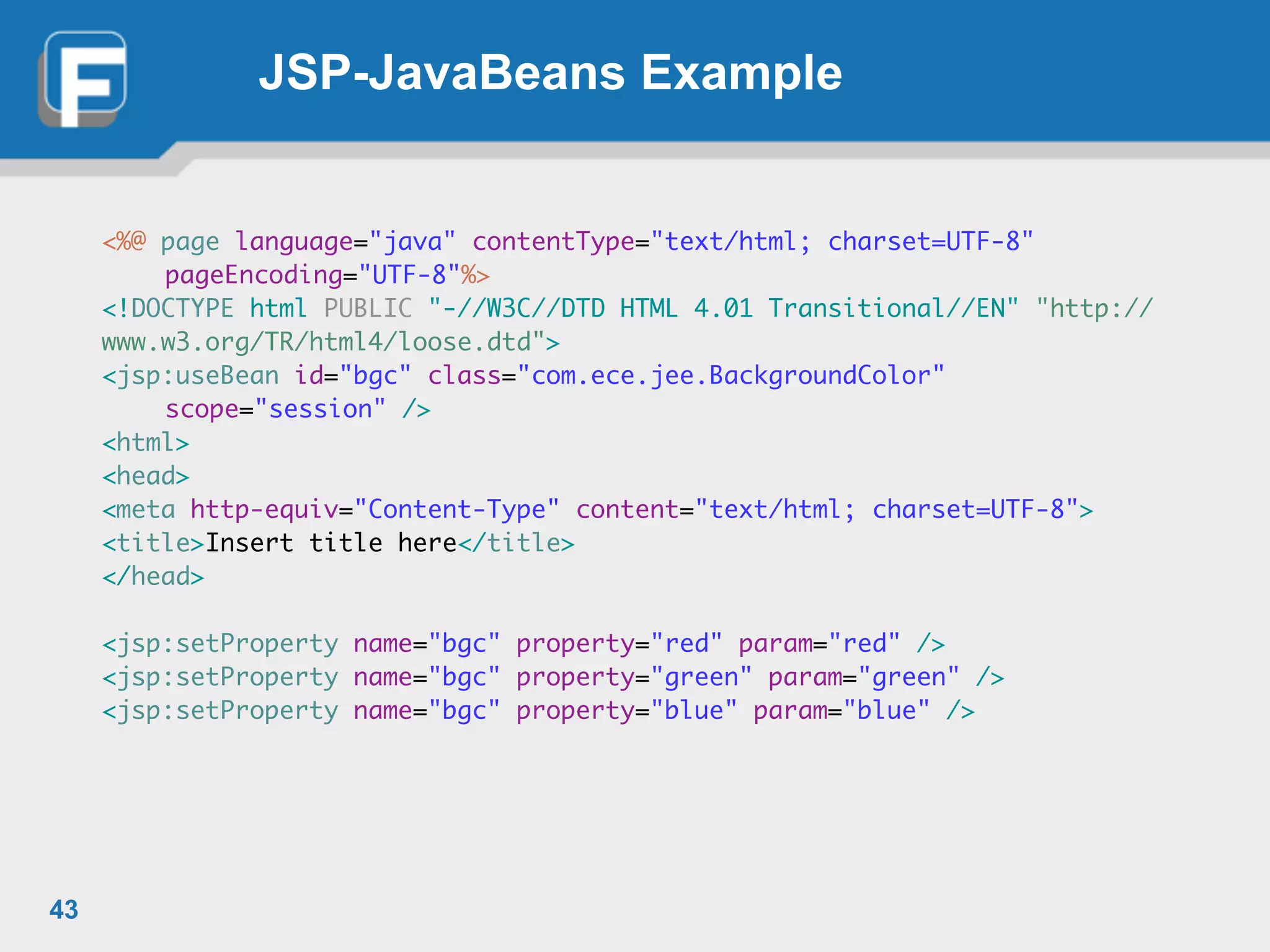
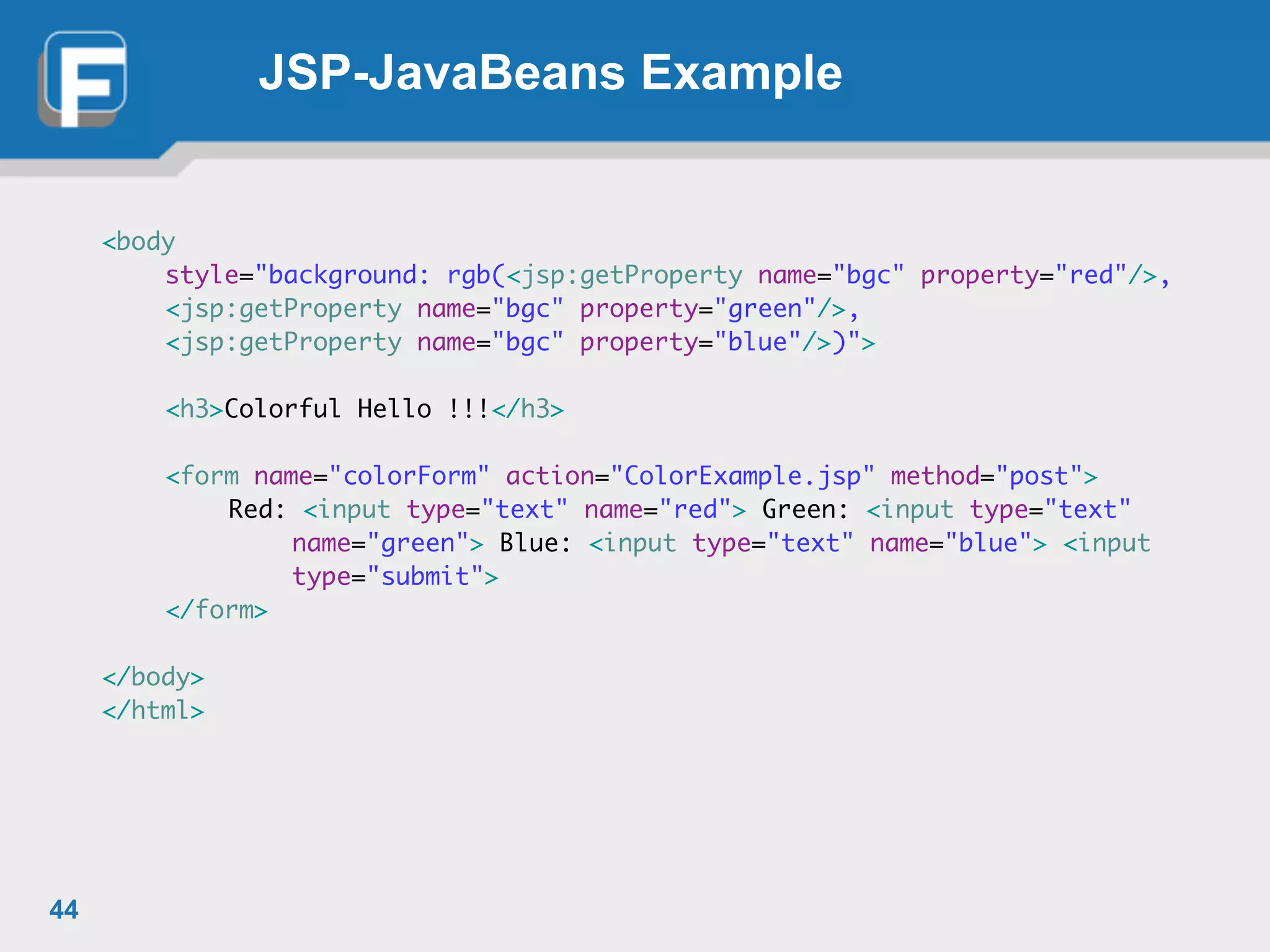
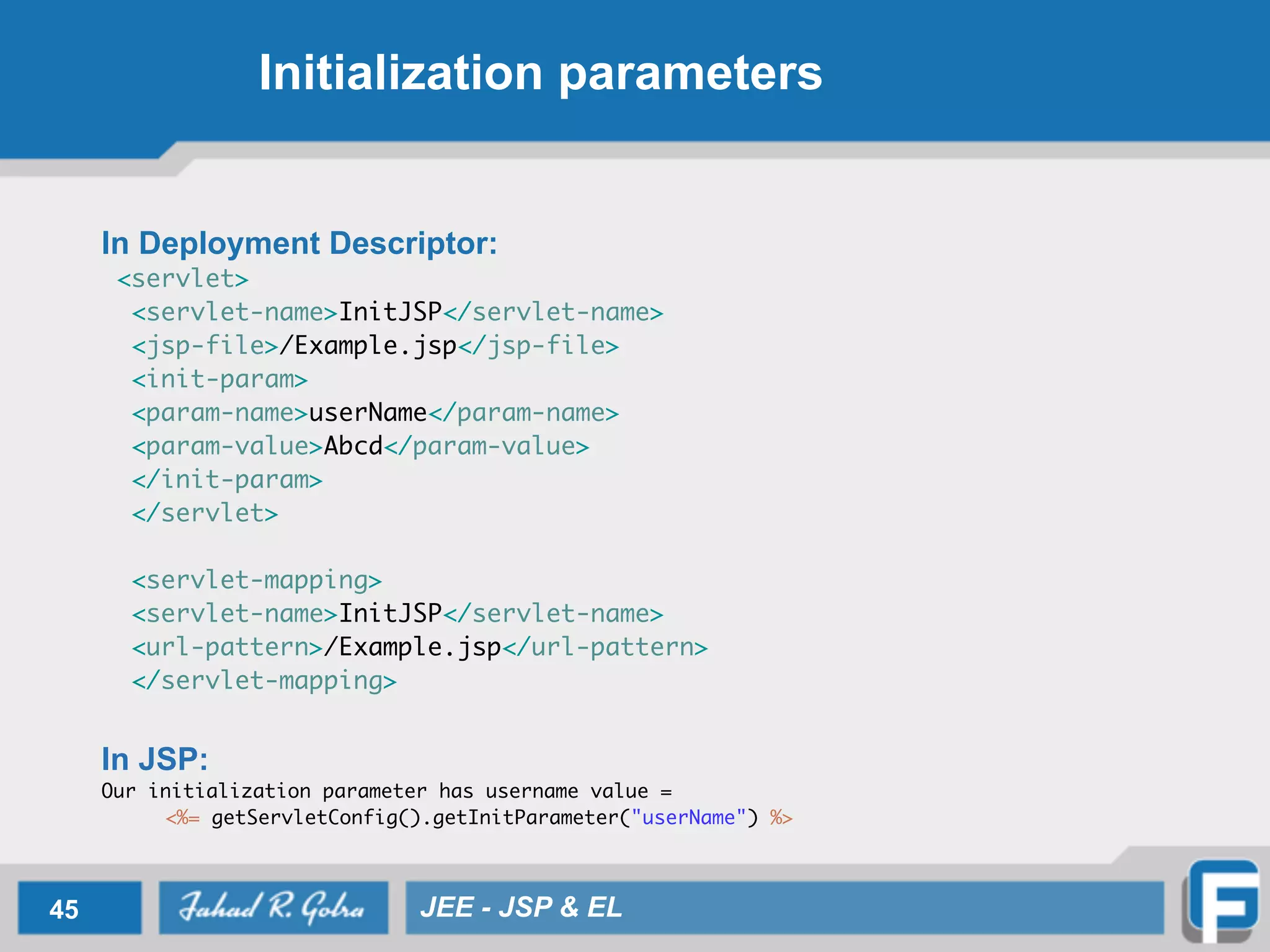
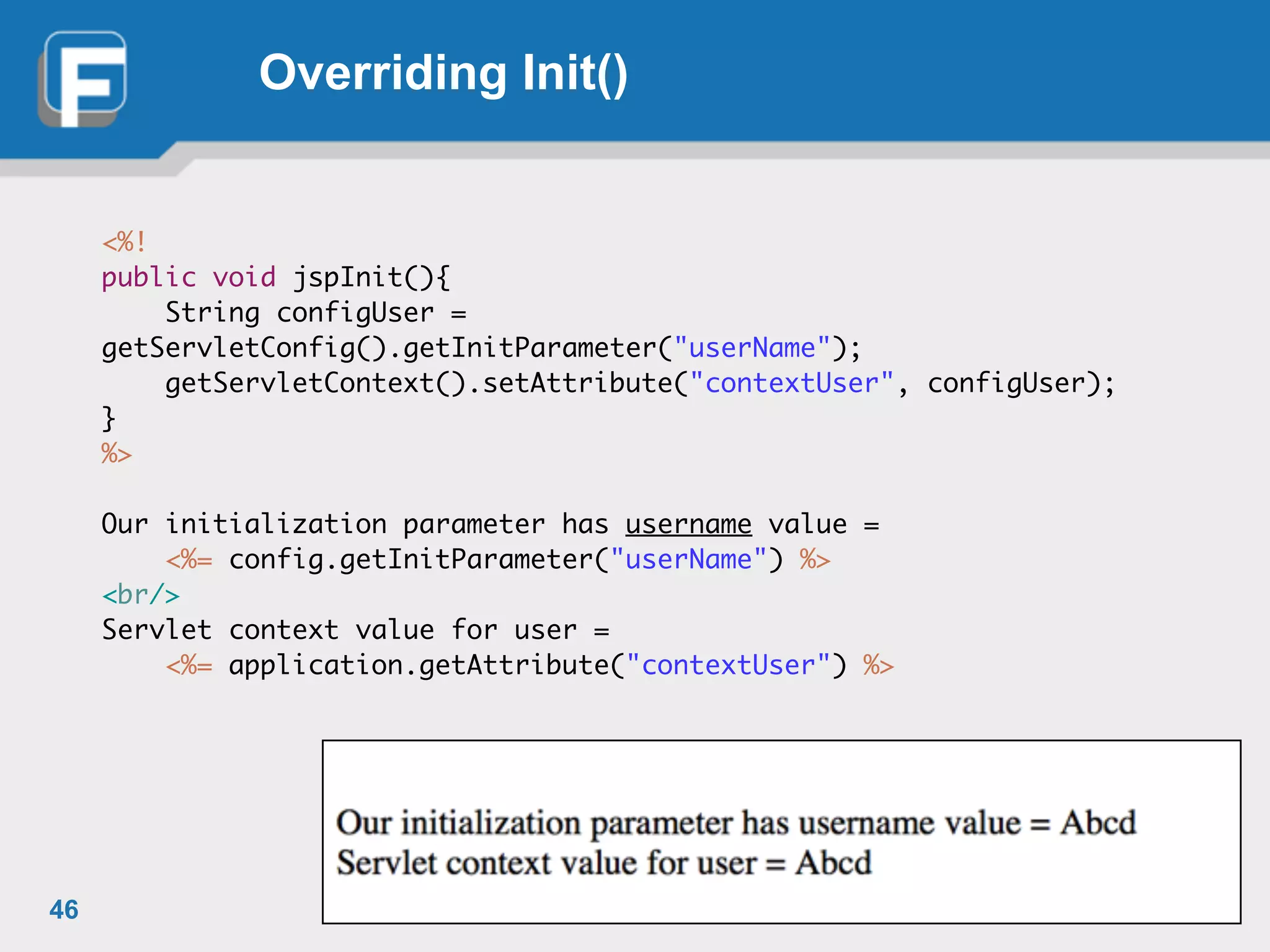
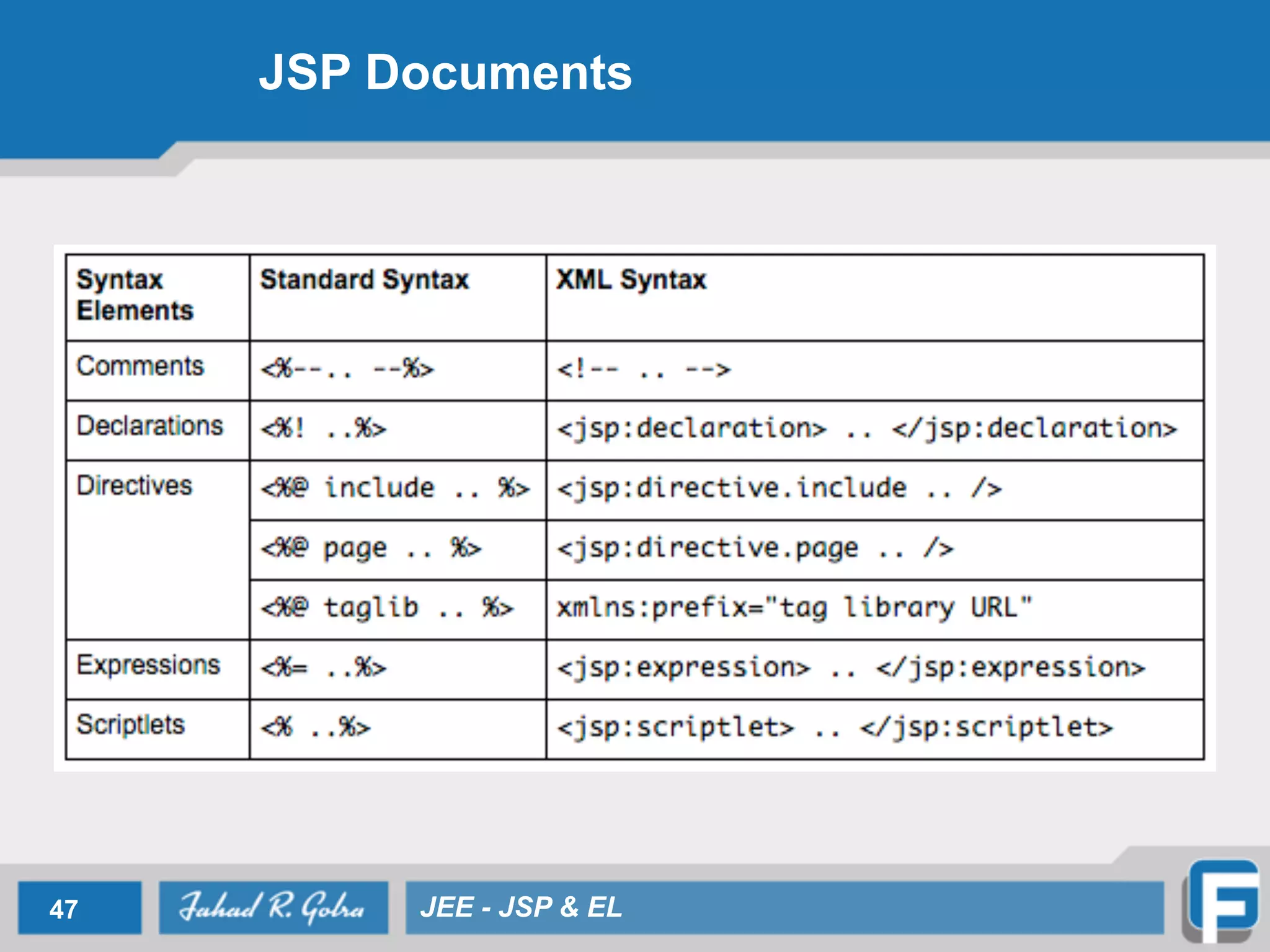
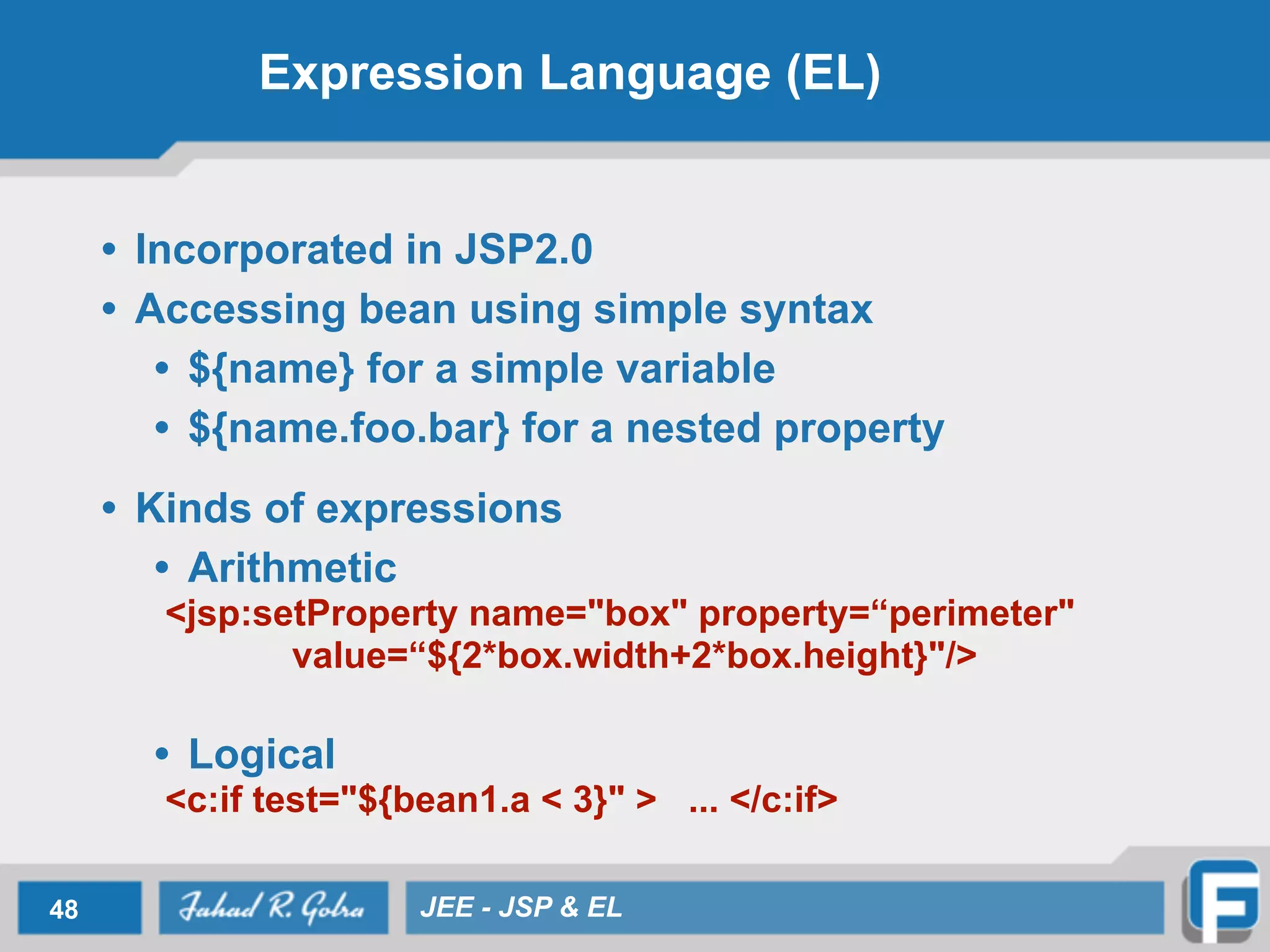
![Operators in EL
49 JEE - JSP & EL
Operator Description
. Access a bean property or Map entry
[] Access an array or List element
( ) Group a subexpression to change the
evaluation order
+ Addition
- Subtraction or negation of a value
* Multiplication
/ or div Division
% or mod Modulo (remainder)](https://image.slidesharecdn.com/lecture4-jspel-141024065534-conversion-gate01/75/Lecture-4-JavaServer-Pages-JSP-Expression-Language-EL-49-2048.jpg)



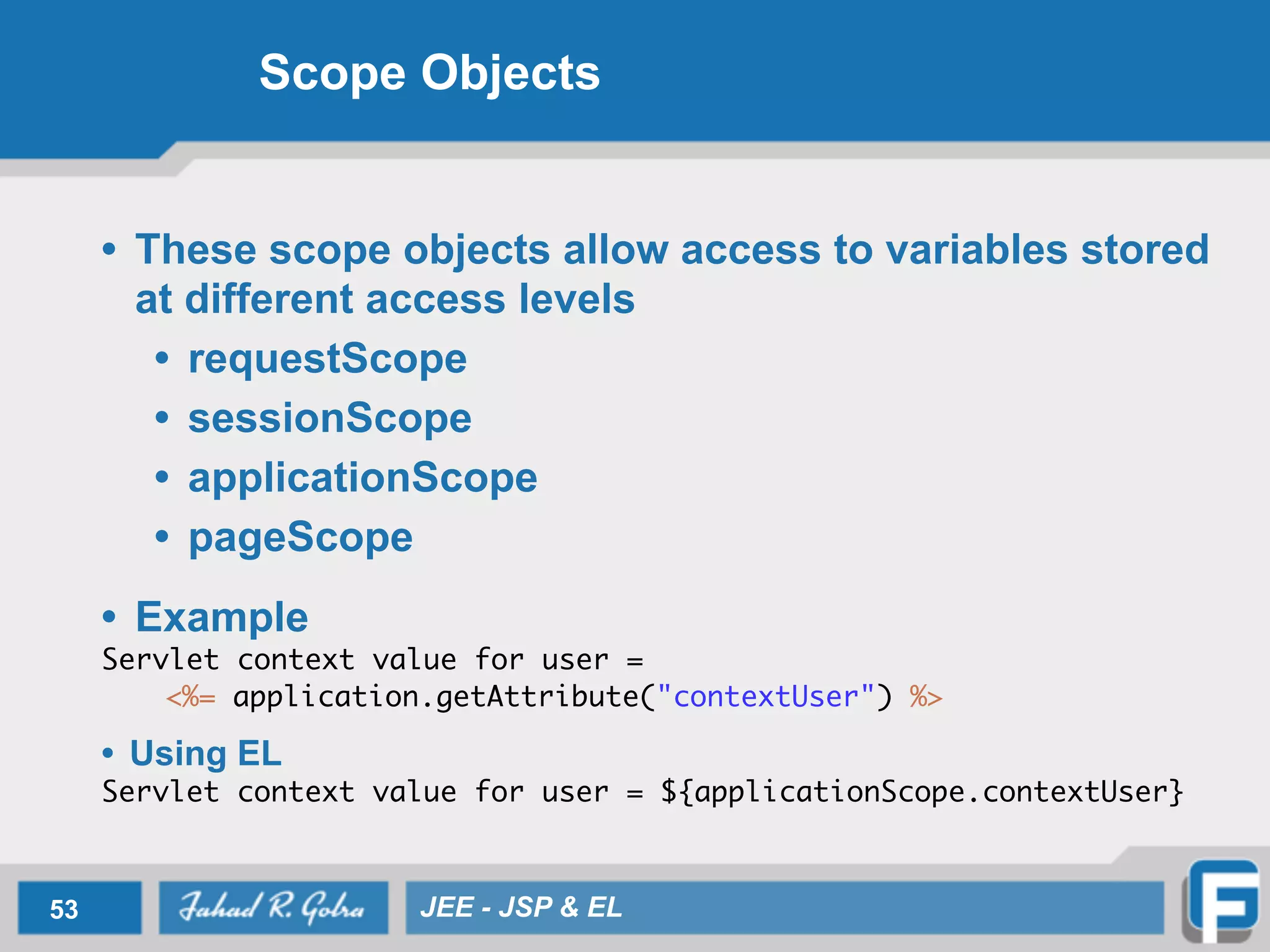
![Handling Attributes
• EL is used to read values, not to set values, JSP
serves as “view” in MVC
!
• In Servlet
request.setAttribute(“contextUser”,cu);
!
• Using EL
${requestScope[“contextUser”].name}
${sessionScope[“contextUser”].name}
${applicationScope[“contextUser”].name}
54 JEE - JSP & EL](https://image.slidesharecdn.com/lecture4-jspel-141024065534-conversion-gate01/75/Lecture-4-JavaServer-Pages-JSP-Expression-Language-EL-54-2048.jpg)
![Param & ParamValues
• Gives you access to parameter values using
request.getParameter and
request.getParameterValues methods
!
• Example: for a parameter named password
${param.password}
${param[“password”]}
55 JEE - JSP & EL](https://image.slidesharecdn.com/lecture4-jspel-141024065534-conversion-gate01/75/Lecture-4-JavaServer-Pages-JSP-Expression-Language-EL-55-2048.jpg)
![Getting Header Information
• In JSP
<%= request.getHeader(“host”)%>
!
• With EL
${header.host}
${header[“host”]}
56 JEE - JSP & EL](https://image.slidesharecdn.com/lecture4-jspel-141024065534-conversion-gate01/75/Lecture-4-JavaServer-Pages-JSP-Expression-Language-EL-56-2048.jpg)
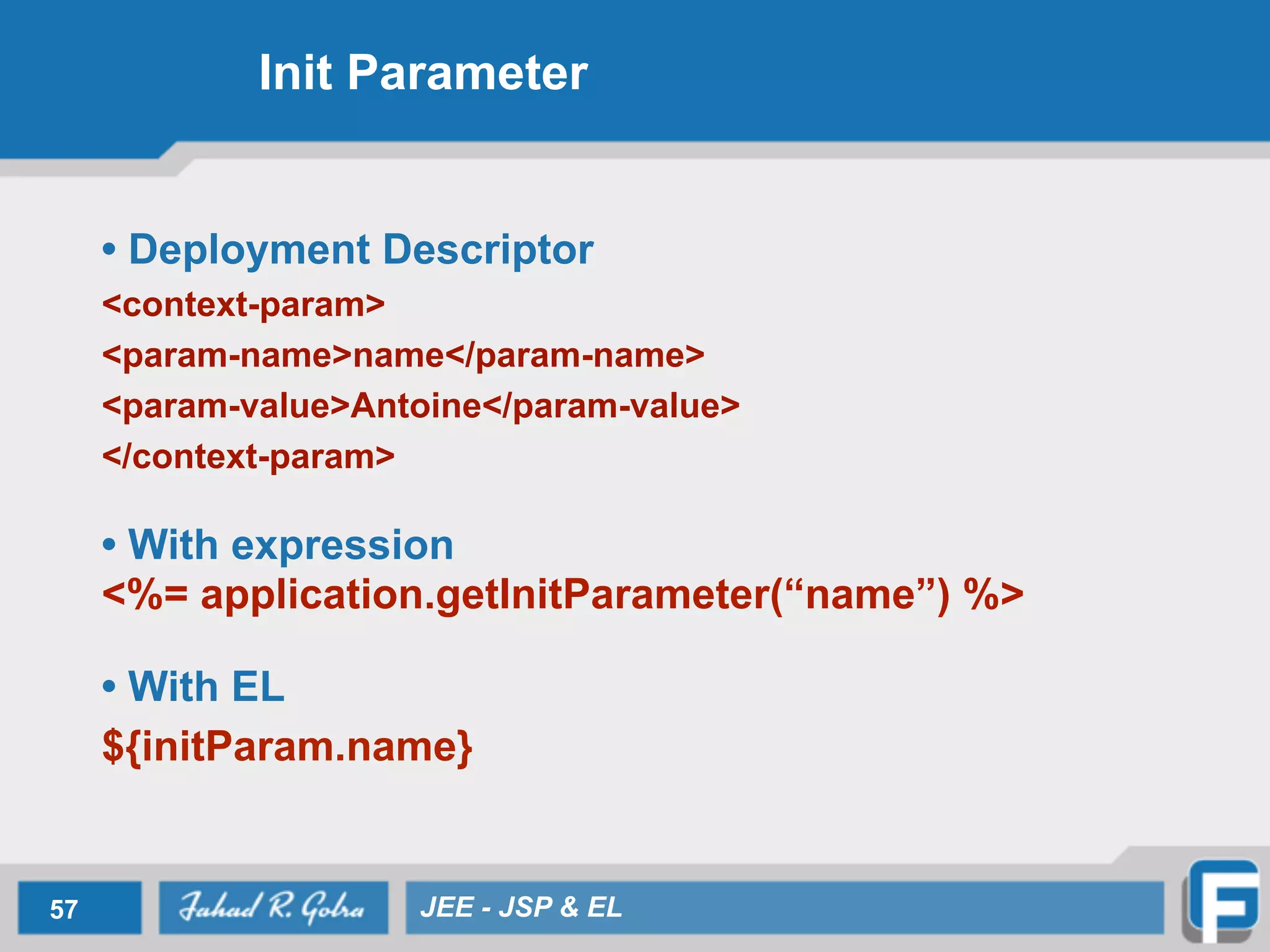
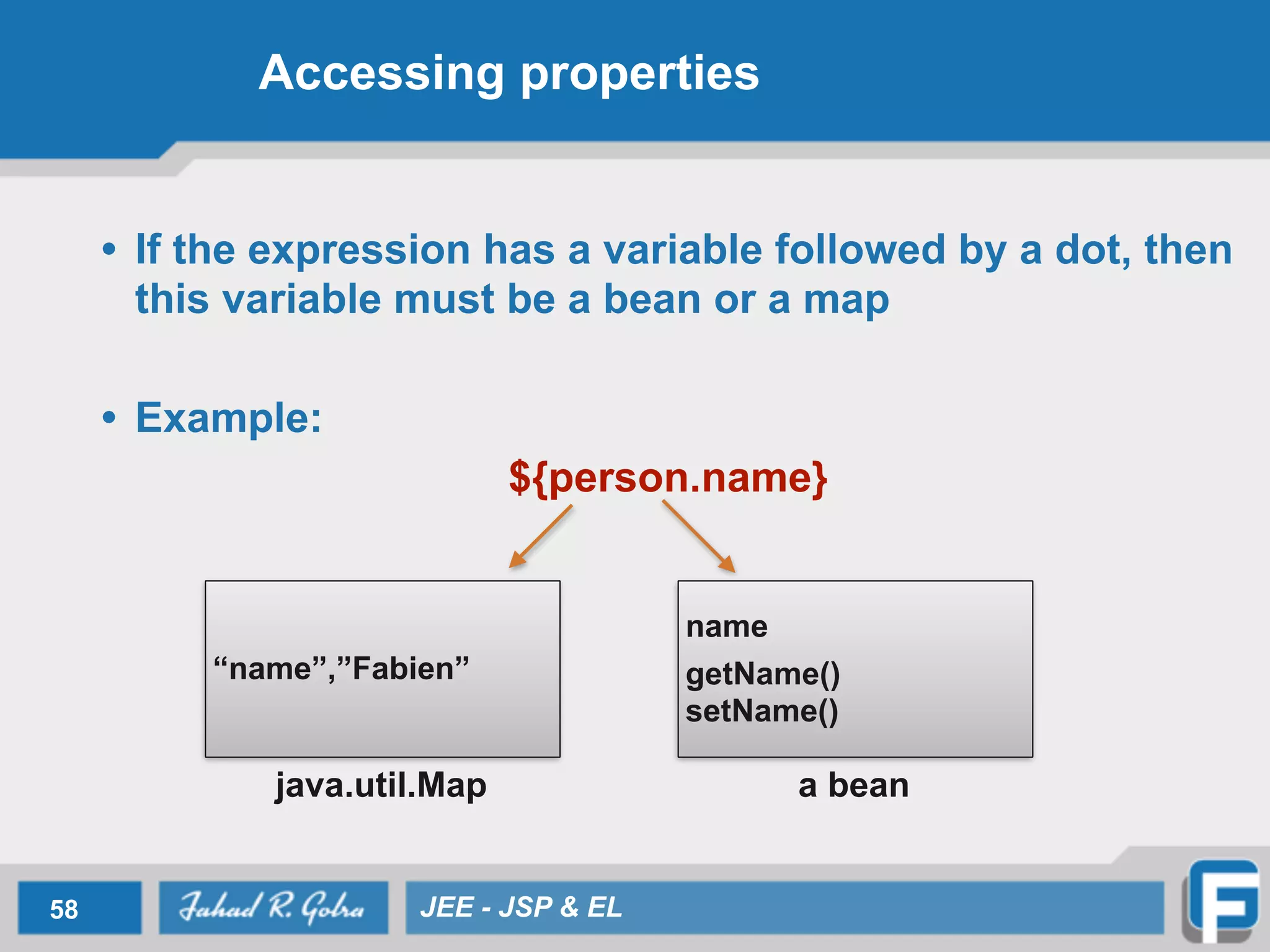
![Accessing properties
• If the expression has a variable followed by a bracket,
then this variable must be a bean, a map, a List or an
Array
!
• Example:
${person[name]}
59 JEE - JSP & EL
“name”,”Fabien”
name
!
getName()
setName()
java.util.Map a bean
1. Fabien
2. Antoine
3. Serge
1.Fabien 2.Antoine 3.Serge
an Array
a List](https://image.slidesharecdn.com/lecture4-jspel-141024065534-conversion-gate01/75/Lecture-4-JavaServer-Pages-JSP-Expression-Language-EL-59-2048.jpg)
![Array
<%!
String[] nameList = {"Alpha","Bravo","Charlie"};
%>
!
<% request.setAttribute("name", nameList);%>
Name : ${name}
<BR />
Name : ${name[0]}
<BR />
Name : ${name["0"]}
60 JEE - JSP & EL](https://image.slidesharecdn.com/lecture4-jspel-141024065534-conversion-gate01/75/Lecture-4-JavaServer-Pages-JSP-Expression-Language-EL-60-2048.jpg)
![HashMap
<%!
Map<String,String> studentMap = new HashMap<String,String>();
%>
!
<%
studentMap.put("name","Fabien");
request.setAttribute("studentMap", studentMap);
%>
!
Name : ${studentMap.name}
<BR />
Name : ${studentMap[name]}
<BR />
Name : ${studentMap["name"]}
61 JEE - JSP & EL](https://image.slidesharecdn.com/lecture4-jspel-141024065534-conversion-gate01/75/Lecture-4-JavaServer-Pages-JSP-Expression-Language-EL-61-2048.jpg)
